Ben Jackson and the evolution of the Digital Twin


Licensed by Dubai Development Authority 105 SEPTEMBER 2023
Creating Value through Data
ECO-AWARE Getting to grips with Nature-Based Infrastructure TRADING Capitalise on the market vision of Ruggero Danielli BORDERLINE Top tips on managing and delivering perimeter security
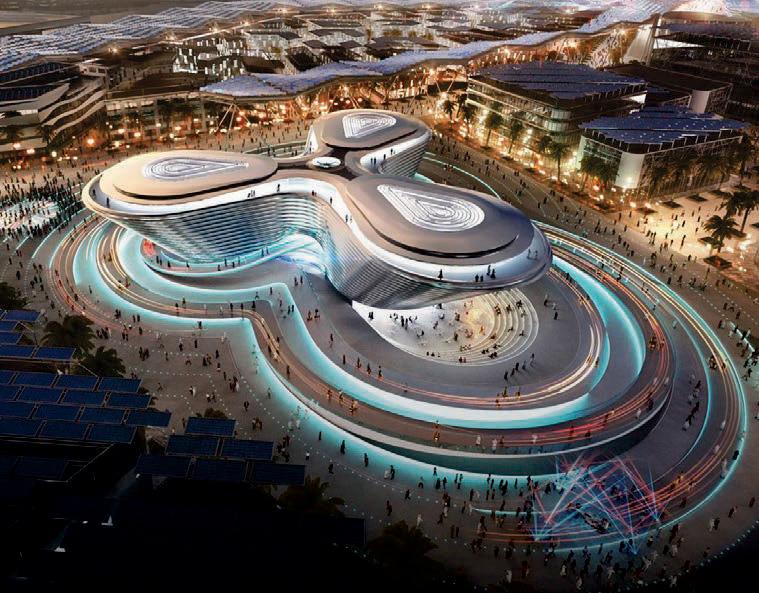



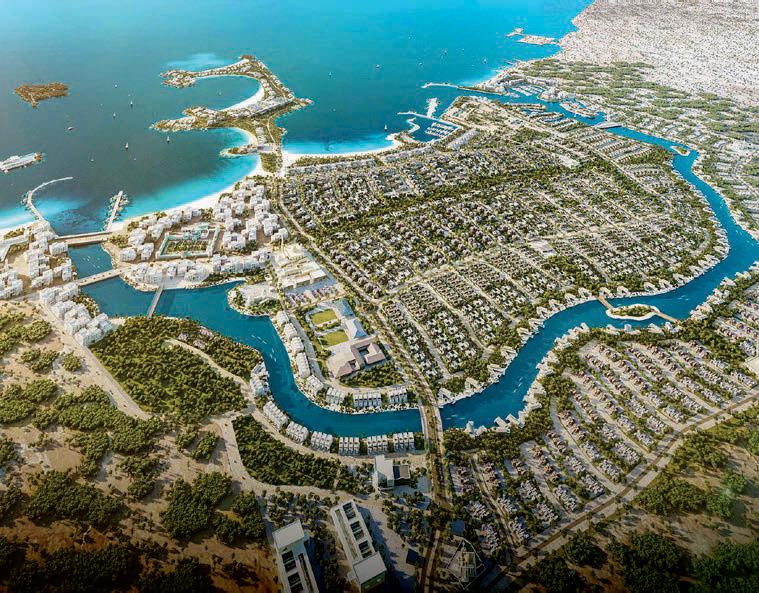


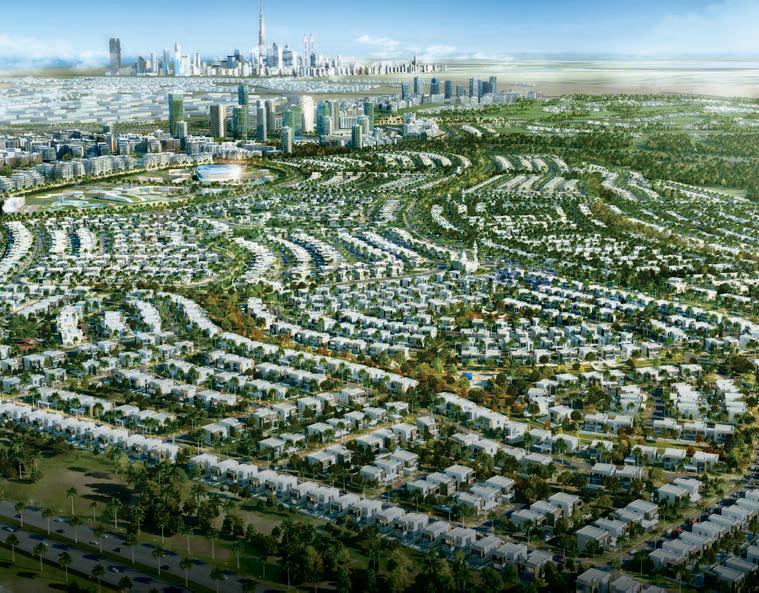




2015, 2016, 2018, 2019, 2020, 2021 & 2022 COST CONSULTING COMPANY OF THE YEAR COMPANY OF THE YEAR 2021
UAE Real Estate Market
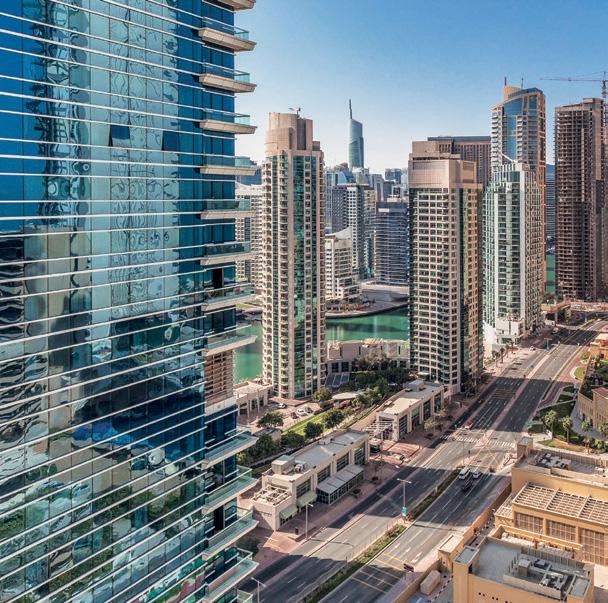
Q2 2023 Overview
Emirates witness soaring off-plan transactions, signalling continued investor confidence: JLL
September 2023 Issue 105
Cover Story
“We create value”
The real estate, development and consultancy sectors are constantly talking about the likelihood of a more digitised future, and the benefits that it will bring in terms of market knowledge and returnon-investment. Yet what is actually being done here in practical terms?
We spoke to Ben Jackson, JLL’s Head of Project and Development Services, Middle East and Africa

What Price a Biophiliac Future?
More than 2.5bn people are expected to migrate to cities before 2045, giving rise to many movements concerned with making the urban experience more sustainable. ME Consultant spoke to IISD - the International Institute for Sustainable Development - to find out more

September 2023 meconstructionnews.com Contents | 01
On Topic
In Practice
26 08
18
The Trader’s Advantage
Middle East Consultant speaks to Ruggero Danielli, Co-Founder of OverviewFX, about potential gains, market-making information and the best in online trading…

Urban Planning & Tomorrow’s World

In what is an intense and often anxious time for urban planners, Paul Godfrey takes a detailed look at the seven key layers of urban planning and what they can each set out to achieve…
Infrastructure Challenges of New Generation Cities
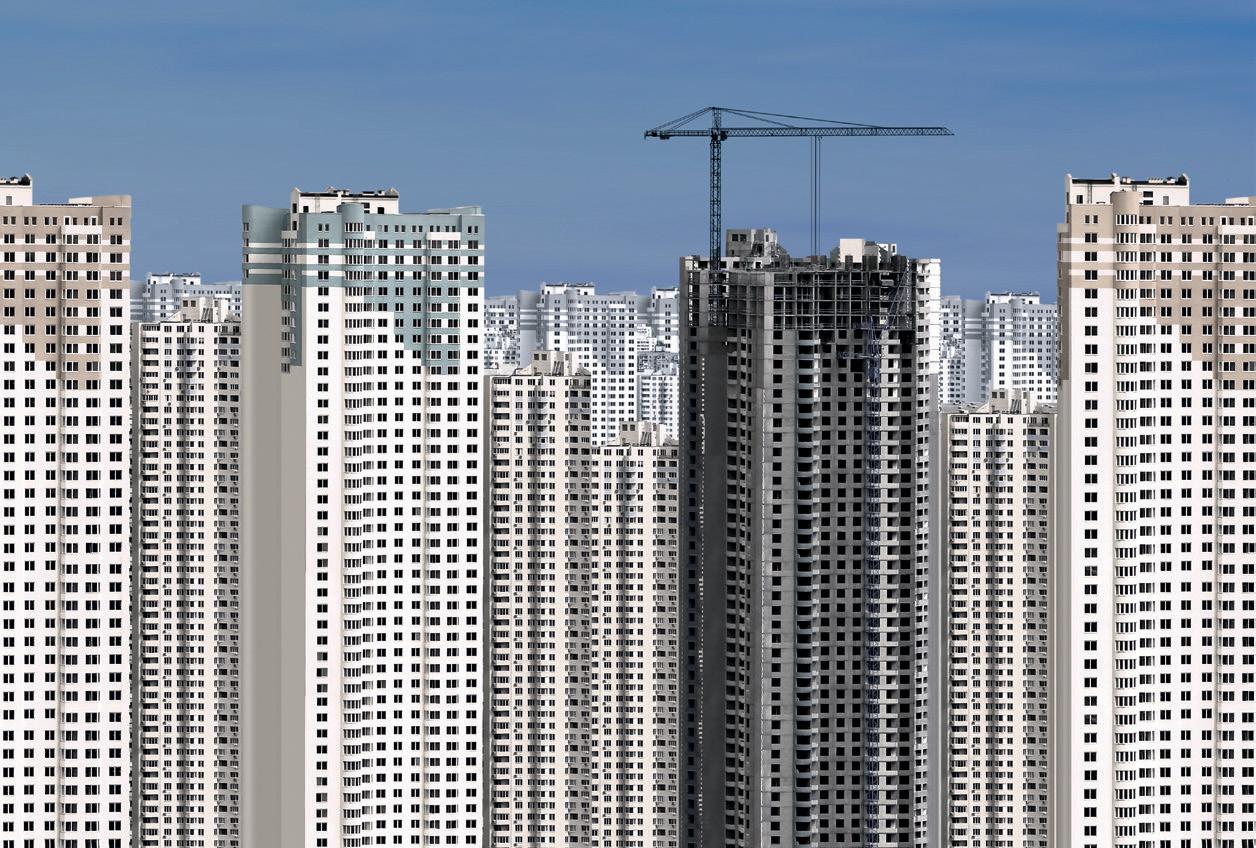
With the astonishing rise of the mega-city and the ongoing creation of completely new, purpose-built urban hubs, the challenges of infrastructure provision have never been more intense. Sameem Gaffar, Executive Vice President - Internationalization, Morgenthau Stirling, inc., investigates…
Sustainability
Certifying ‘Green’
Hospitality
Margarita Huaca, Engineer & Sustainable Development Expert - Business Development, ENERNOUVA, assesses the power of sustainable certification

September 2023 meconstructionnews.com 02 | Contents
In Practice
38
In Practice
34 24 30
Ÿ
Ÿ
Ÿ
Ÿ
Ÿ
Ÿ
Threat & Risk Assessment
Gap Analysis
Security System Design

IT/AV Design
Master Planning & Development
Operational Requirements
Ÿ
Ÿ
Ÿ
Ÿ
Ÿ
Ÿ
Testing & Commissioning
Control Room Design
System Integration
Policies & Procedures
Site Surveys & Audits
Crisis Management
That Nusantara feeling…
Here in our September issue, the feature ‘Urban Planning and Tomorrow’s World’ starts with this sentence: “It’s a truism that there has never been so much emphasis on urban planning as there is right now. While in the USA, UK and western Europe, the 1960s and early ‘70s were peak times for reconsidering the growth of cities and the provision of numerous ‘new towns’, the urban explosion has now spread to the far corners of the globe.”
This is perhaps much truer than any of us might imagine. For example, while more than 2.5bn people are expected to move to cities by 2050, what is perhaps more disconcerting is that our present understanding of what are the world’s biggest urban centres is set to change completely.
By 2050, it’s predicted that the largest four cities in the world will be (in descending order): Mumbai (India); Delhi (India); Dhaka (Bangladesh); Kinshasa (DRC). What’s more, six of the next 10 will be in South America. In other words, our typology of what constitutes ‘big cities’ - and the land masses they are the very essence of - will change 100%. Gone from
those lists are Tokyo, Shanghai, New York and Moscow. Gone forever, probably.
Perhaps it’s the fact that, working here in the GCC, we might expect to see more talk of the Saudi giga-projects on this list; or - much more likely - that we’re far too accustomed to our traditional, familiar world view. In that perspective on things, completely new cities like Nusantara (set to be inaugurated as the new capital of Indonesia in 2024) and Telosa (slated to be 10 times bigger than Las Vegas and being built in the Nevada desert), don’t figure at all; like, where did all these places suddenly come from?
The reality is that this new-era urban explosion is going to push the bar far higher in terms of fresh urban planning and architectural skillsets than has ever been previously imagined. Moreover, a large measure of that will be AI-generated - and dimensions away from the majority of human input at all.
Are we ready for the new urban challenge?
Group
MANAGING DIRECTOR
RAZ ISLAM raz.islam@cpitrademedia.com
+971 4 375 5471
MANAGING PARTNER
VIJAYA CHERIAN vijaya.cherian@cpitrademedia.com
+971 4 375 5713
DIRECTOR OF FINANCE & BUSINESS OPERATIONS
SHIYAS KAREEM shiyas.kareem@cpitrademedia.com
+971 4 375 5474
PUBLISHING DIRECTOR ANDY PITOIS andy.pitois@cpitrademedia.com
+971 4 375 5473
Editorial
EDITOR PAUL GODFREY paul.godfrey@cpitrademedia.com
+971 4 375 5470
Design

ART DIRECTOR SIMON COBON
GRAPHIC DESIGNER PERCIVAL MANALAYSAY
PHOTOGRAPHER
MAKSYM PORIECHKIN
Circulation & Production
DATA & PRODUCTION MANAGER
PHINSON MATHEW GEORGE phinson.george@cpitrademedia.com
+971 4 375 5476
Marketing & Events
EVENTS EXECUTIVE
MINARA SALAKHI minara.s@cpitrademedia.com
+971 4 433 2856
Web Development
ABDUL BAEIS UMAIR KHAN
FOUNDER DOMINIC DE SOUSA (1959-2015)

September 2023 meconstructionnews.com
04 | Welcome
Published by The publisher of this magazine has made every effort to ensure the content is accurate on the date of publication. The opinions and views expressed in the articles do not necessarily reflect the publisher and editor. The published material, adverts, editorials and all other content are published in good faith. No part of this publication or any part of the contents thereof may be reproduced, stored or transmitted in any form without the permission of the publisher in writing. Publication licensed by Dubai Development Authority to CPI Trade Publishing FZ LLC. Printed by Al Salam Printing Press LLC. CPI Trade Media. PO Box 13700, Dubai, UAE. +971 4 375 5470 cpitrademedia.com © Copyright 2023. All rights reserved.
Editor, Middle East Consultant
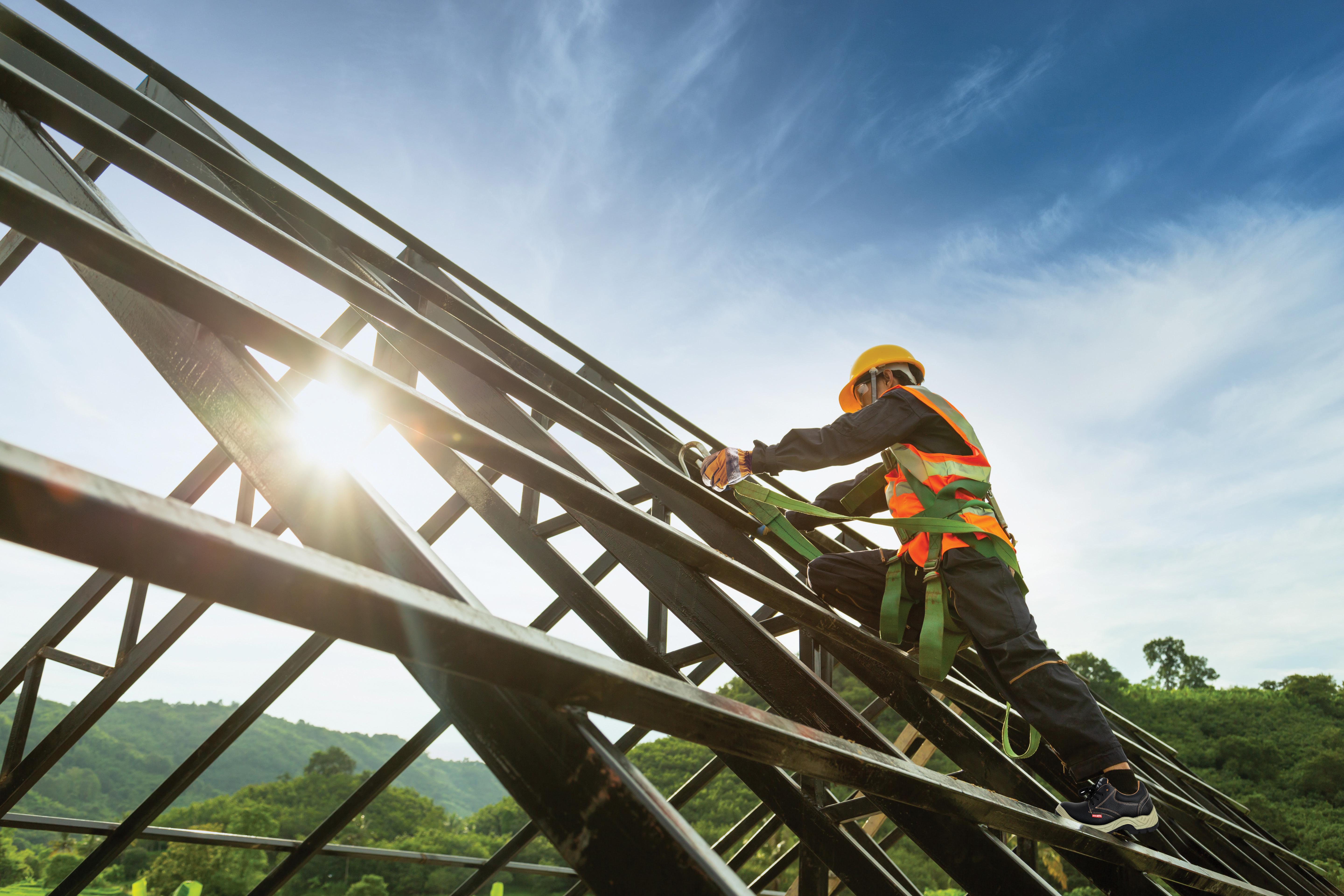
CONSTRUCTION
Lamprell wins major offshore project

EVENT: GCC infrastructure to be put in the spotlight at new summit on 15 November


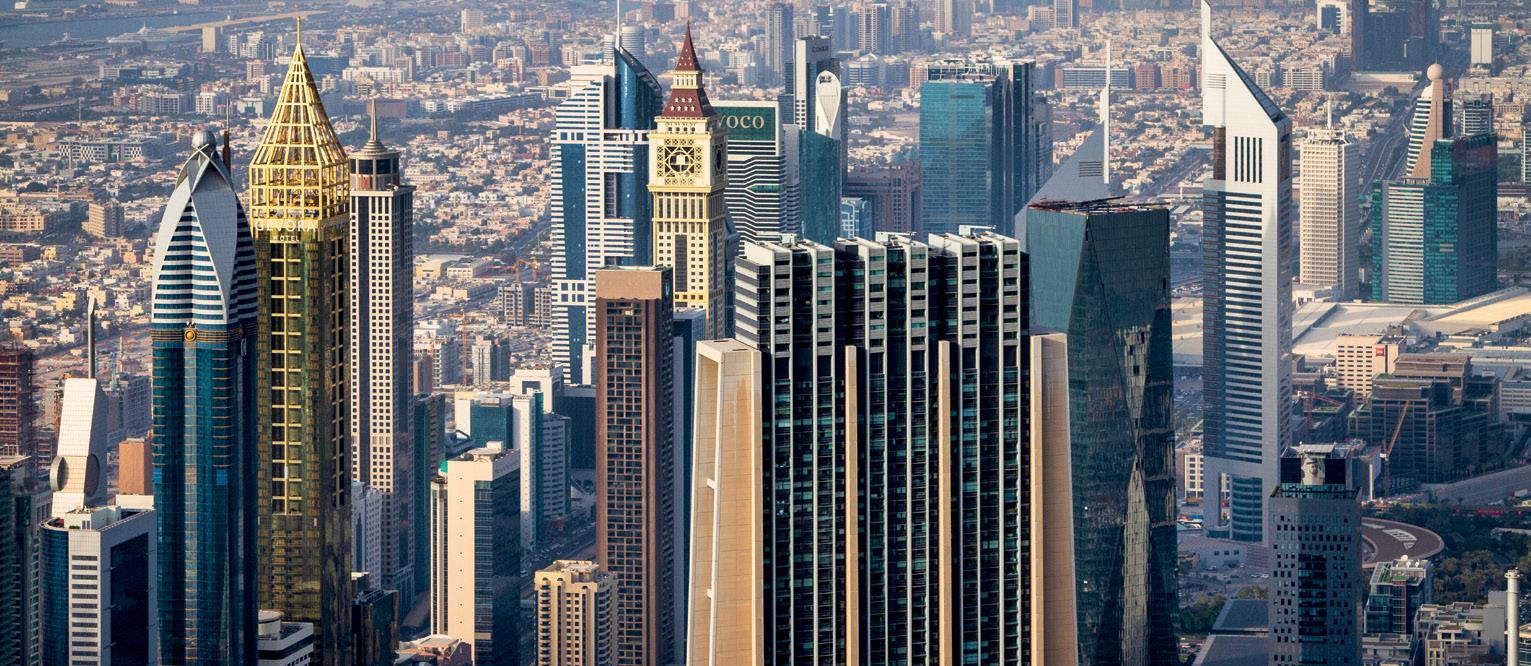

CONSTRUCTION
Designs for Equinox Resort
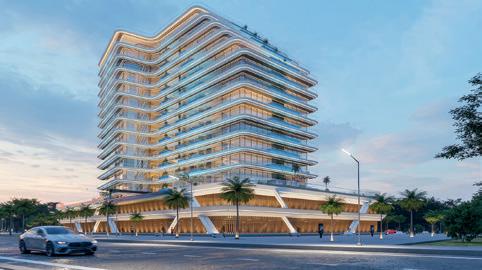

Amaala revealed
OPERATIONS
JLS Yachts will join Sindalah ecosystem
FEATURE: Getting serious about sustainability
PROPERTY Samana Developers launches Samana Golf Views

EXPERTS: Shifting customer demands sparking transformation in real estate market
CONSTRUCTION
Tenders issued for Bahrain gas units
Cutting-edge technology is transforming the delivery and sustainable operation of regional megaprojects
September 2023 meconstructionnews.com REGISTER NOW 26 September 2023 Habtoor Grand Resort / Dubai
06 | On Topic LATEST NEWS FEATURES
PROPERTY
Fujairah issues two new Property laws Stakeholders will be given six months to align with legal requirements of property ownership rulings


INFRASTRUCTURE
World record bid submitted for Dubai desalination plant Acwa Power leads competitive tenders for DEWA’s Hassyan Phase 1 project
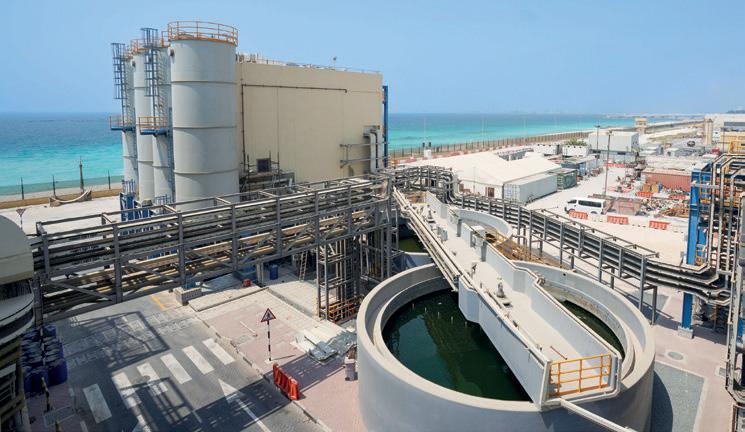
CONSTRUCTION
Parsons awarded five-year project and construction management contract to expand KAFD Firm developing commercial, hospitality, residential, municipal, mixed-use buildings and infrastructure for the Riyadh development

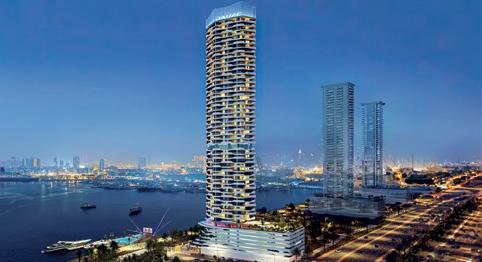
MACHINERY
Mammoet launches zero emissions option for SPMT transport





The new equipment works by converting existing SPMTs from diesel to electric power
SUSTAINABILITY
Adnoc and Tabreed to decarbonise cooling through use of geothermal energy
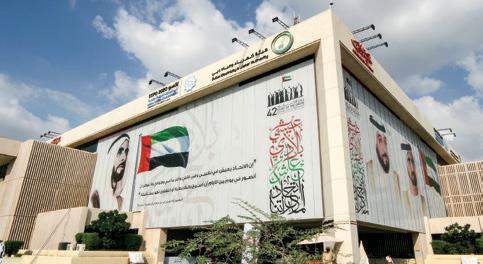
Currently, the cooling of structures accounts for the majority of the UAE’s electricity consumption
ENERGY
DEWA
CONSTRUCTION
Construction
PROPERTY
Damac
CONSTRUCTION
UAE-Oman
PROPERTY
September 2023 meconstructionnews.com On Topic | 07 MOST POPULAR FEATURED NEWS NOMINATE NOW 22 November 2023 | The Ritz Carlton JBR / Dubai / UAE
patents innovative energy storage liquid
Plans underway to accelerate Sharjah property sector
Coral Reef to use exclusive Faudemer designs
Railway announces competitive tender
of world’s largest offshore wind farm commences

meconstructionnews.com September 2023 8 | On Topic
UAE Real Estate Market Q2 2023 Overview
Emirates witness soaring off-plan transactions, signalling continued investor confidence: JLL
n Dubai, off-plan residential sales increased by 38% in value and 30% in volume during Q2 when compared to the same period last year, according to data from Dubai Pulse. The majority (57%) of the transactions in the category were recorded between AED 500,000 and AED 2 million, with investors primarily focusing on studios and 1BR units in areas like JVC, Dubailand, and MBR City.
Similarly, the off-plan market in Abu Dhabi maintained its strong performance during the quarter. As per data from Quanta, the value of off-plan transactions more than doubled from AED 1.8 billion in Q2 2022 to AED 3.8 billion in Q2 2023, with the majority of activity concentrated between AED 2 and 3 million, driven by villa transactions on Al Reem Island and Yas Island.
Overall, in the residential segment, the delivery of 7,300 units in Dubai during the quarter raised the total residential
stock to 700,000 units, with an additional 21,000 units slated to be handed over in the remaining half of this year. In Abu Dhabi, the addition of 1,000 units brought the total residential stock to 283,000 units. In terms of future supply, close to 3,000 units are in the pipeline for 2023, mainly comprising apartments within master-planned communities such as Al Raha Beach, Al Maryah Island, and Al Reem Island.

In general, Residential market performance continued to improve in Dubai, with a 16% uptick in sale prices and 24% in rentals in May 2023 when compared to the same period last year. Demand for high-quality luxury products persisted in established mixed-use communities. In the capital, sale prices and rentals were marginally up by 1% each as outdated stock on the main island continued to face pressure from newer high-end communities. This trend is likely to continue as the emirate draws demand toward upcoming new islands.

September 2023 meconstructionnews.com On Topic | 9
Burgeoning market values are reflected across both residential and commercial properties, with residential supply projecting 3,000 further units in 2023.
Faraz Ahmed, Associate, Research at JLL MENA, said: “In the second quarter, all sectors demonstrated strength and adaptability propelled by new and emerging trends. The continued growth in off-plan transactions, rising demand for quality office spaces, evolving retail offerings, and transformative renovations in the hotel sector, collectively indicate the dynamism of Dubai and Abu Dhabi as vibrant investment destinations. With strong investor confidence, robust absorption of new projects, and innovative developments, there is no doubt that these cities are paving the way for sustained growth and transformation across the entire real estate landscape in the UAE.”
RISING RENTS AND LIMITED AVAILABILITY IN PRIME LOCATIONS FORCE OCCUPIERS TO REASSESS THEIR SPACE STRATEGY
On the back of attracting a diverse mix of tenants from all segments, Dubai’s office market continued to witness strong demand. That said, owing to the low availability of good-quality office space and the healthy inflow of new market entrants, co-working and serviced offices served as an initial landing pad for most new players while they explored long-term options. Consequently, average Grade A rents within the Central Business District (CBD) increased by 18% year-on-year
(Y-o-Y) to AED 2,300 per sq. m. per annum in the second quarter while office vacancy within the CBD was logged at 10%.
In the capital, both the number of office inquiries, and the amount of space being sought increased over the past quarter, primarily driven by the defense, technology, and financial industries. Demand for Grade A space continued to surge due to limited availability resulting in average city-wide Grade A rents rising by 11% Y-o-Y to AED 1,900 per sq. m. per annum. The demand for co-working and serviced offices also remained resilient as corporates continued to follow hybrid working models.
Largely, occupiers are being compelled to change their strategy due to rising rents and limited availability of space in prime locations. While some reassessed their needs and settled for what was available in the market, others had to broaden their search to include secondary locations offering Grade B/B+ spaces. Those with more stringent requirements are having to explore built-to-suit opportunities to fit their needs.
There were no office projects completed in either Dubai or Abu Dhabi during the second quarter, keeping the total supply stable at 9.1 million sq. m. in Dubai and 3.9 million sq. m. in the capital. Over the second half of 2023, approximately 99,000 sq. m. and 41,000 sq.
m. of office gross leasable area (GLA) are expected to enter Dubai and Abu Dhabi, respectively.
F&B CONTINUES TO BE A KEY SECTOR DRIVING FOOTFALL ACROSS RETAIL DEVELOPMENTS
With the ambition to enhance customer experience and introduce new concepts, Mall owners have been exploring plans to elevate their offerings by either upgrading traditional food courts or adding new modern food halls. The upcoming “Market Island” in Dubai Festival City is one such example. These new food halls are generally intended to attract high-end F&B brands.
In terms of the retail segment as a whole, around 6,000 sq. m. of space was added in Dubai in Q2, bringing the entire stock to 4.7 million sq. m. In the remaining months of this year, around 83,000 sq. m. of retail GLA is scheduled to be delivered across the emirate, the majority of which will be in the form of expansion of a superregional mall and new neighbourhood malls. In Abu Dhabi, about 2,000 sq. m. of retail space was completed, which raised the total stock to 3.1 million sq. m. It is further anticipated that another 58,000 sq. m. retail space will be finished in the second half of this year.
Well-located retail developments benefited from the growing number of
meconstructionnews.com September 2023
10 | On Topic
Dubai Office Supply 9.1m Total stock (sq m GLA) 99k 2023 deliveries (sq m GLA) +18% Average Grade A rental rates Abu Dhabi Office Supply 3.9m Total stock (sq m GLA) 41k 2023 deliveries (sq m GLA) +11% Average Grade A rental rates Dubai Residential Supply 700k Total residential stock 21k Expected 2023 deliveries +24% Average rental rates change Abu Dhabi Residential Supply 283k Total residential stock 3k Expected 2023 deliveries +1% Average rental rates change
tourists in Dubai. While prime retail developments were operating at near full occupancy, community malls and retail developments in secondary locations noted a slight decrease in activity, as footfall remained dominant in larger regional and super-regional malls. As a result, average rental values in primary and secondary malls fell by 2% in Q2 compared to the same quarter in the previous year.
In Abu Dhabi, broadly, the retail market maintained stable rental performance visà-vis the second quarter of 2022. That said certain landlords, particularly those in older developments, faced pressure due to increased competition from new retail developments. However, unlike in Dubai, landlords were more accommodating and offered incentives such as capex support, honeymoon trade periods, revenue sharebased deals, and extended fit-out periods for established international brands.
RENOVATIONS AND INNOVATIONS TO DRIVE TRANSFORMATION IN DUBAI AND ABU DHABI‘S HOTEL SECTOR
Following an exceptional last year, Dubai’s hotel market began to show signs of stabilisation in Q2 2023. Using effective revenue management strategies, operators chose to keep occupancy levels higher at the expense of average daily rates (ADR). While ADR decreased by 6% for the year
to (YT)June to USD 188 when compared to the same period last year, occupancy increased to 78% for YT June. Nonetheless, this decline is not a sign of a slowdown but rather a healthy indicator of the market finding its balance.
Even in Abu Dhabi, the hotel industry maintained its steady growth. The capital aims to receive 24 million visitors by the
end of 2023, and the increase in both domestic and international visitors can be attributed to increased awareness of Abu Dhabi as a destination as well as the availability of a broader selection of year-round entertainment, sporting events, trade events, and roadshows. In comparison to the same period last year, the capital’s ADR increased by 26% for YT June to USD 137, while city-wide occupancy surged to 71%. This resulted in a rise of 28% in revenue per available room (RevPar), which stood at USD 97.
With several modern tech-enabled hotels on the market, older legacy hotels need to undergo renovations to remain competitive. These renovations typically concentrate on technological advancements, sustainability measures, and innovative design enhancements. This move aims to bring traditional hotels up to date with industry standards while also catering to changing customer preferences.
With regard to the inventory, in the second quarter, around 1,000 keys were added in Dubai, increasing the total supply to 151,000 keys. During the same duration, no notable hotel projects were completed in the capital, keeping the total stock stable at 32,500 keys. In the remaining six months of this year, another 6,000 and 200 keys are slated to be handed over in the former and the latter city, respectively.
meconstructionnews.com
Dubai Retail Supply 4.7m Total stock (sq m GLA) 83k 2023 deliveries (sq m GLA) -2% Average rental rates change Abu Dhabi Retail Supply 3.1m Total stock (sq m GLA) 58k 2023 deliveries (sq m GLA) 0% Average rental rates change Dubai Hospitality Supply 151k Total hotel keys 6k Expected 2023 deliveries 78% Occupancy YT June 2023 Abu Dhabi Hospitality Supply 32.5k Total hotel keys 200 Expected 2023 deliveries 71% Occupancy YT June 2023 On Topic | 11
September 2023
The continued growth in off-plan transactions, rising demand for quality office spaces, evolving retail offerings, and transformative renovations in the hotel sector, collectively indicate the dynamism of Dubai and Abu Dhabi as vibrant investment destinations”

meconstructionnews.com September 2023 12 | On Topic
KSA Real Estate Market Q2 2023 Overview
Government investment in tourism development drives Kingdom’s strong performance in the hospitality sector:
JLL
Similar improvements were also noted in Jeddah’s hospitality market, with the occupancy rate increasing to 64% for YT June 2023. Additionally, for the same period, ADR rose to USD 215, which consequently resulted in RevPAR increasing by 21% to reach USD 137 when compared to the same period last year.
iyadh, Saudi Arabia, 9 August, 2023: The Tourism Development Fund announced signing an agreement with the General Authority for Small and Medium Enterprises as part of efforts to offer support and expand SME operations in the tourism sector. Furthermore, in addition to ongoing visa reforms, a well-planned events calendar is driving the Kingdom’s performance in the hospitality sector, according to JLL’s KSA Real Estate Market Overview Report for Q2 2023.
These factors largely underpinned the strong performance across both Riyadh and Jeddah’s hospitality markets last quarter. The latest data from STR shows Riyadh’s occupancy reached 62% and the average daily rate (ADR) climbed to USD 196 for year to (YT) June 2023, which led to revenue per available room (RevPAR) rising by 15% year-on-year (y-o-y) to USD 120.
While the total existing hotel stock remained stable at 21,000 keys in Riyadh and 16,000 keys in Jeddah in the second quarter, approximately 1,400 keys are scheduled to be handed over in the capital and 600 keys are planned to be completed in Jeddah in the remainder of this year.
“As the Kingdom intends to draw 100 million visitors by 2030 in line with its ongoing diversification efforts, the robust performance in the hospitality sector reflects the success of its numerous strategic initiatives that are helping to boost tourism,” said Saud Alsulaimani, Country Head, KSA, at JLL. “By streamlining visa processes, increasing air connectivity, developing multiple tourist attractions – and ultimately market accessibility – and hosting several local and global events, the Saudi government has made significant efforts to attract investment into the country. Today, the Kingdom is being recognised as one of the world’s biggest investors in tourism, with
existing and new investments set to drive its growth and position it as a year-round tourist destination.”
F&B AND ENTERTAINMENT CONCEPTS CONTINUE TO DRIVE FOOTFALL IN THE KINGDOM
The second quarter saw retail space in Jeddah grow by approximately 102,300 sq. m. to 1.9 million sq. m., whereas the completion of two small neighborhood malls and an expansion of a regional mall added approximately 49,500 sq. m. of retail gross leasable area (GLA) in the capital, increasing the total stock to 3.4 million sq. m. In the second half of this year, 381,000 sq. m. of new retail floorspace is in the pipeline in Jeddah if completed as scheduled, and 58,000 sq. m. of retail space is planned to be handed over in Riyadh.
In Riyadh, average annual rents for super regional and regional malls increased by 9% and 8%, respectively. However, Jeddah’s retail market softened, and average rents for super regional malls decreased by 17% y-o-y in Q2. Conversely, average rents in regional malls in Jeddah increased marginally by 1% when compared to the same period last year.
During the quarter, F&B and entertainment concepts continued to drive footfall in retail developments.
Latest data from the Saudi Central Bank revealed point of sales transactions in the Restaurant & Café category increased in volume by 29% and in value by 16% for the period of January to May 2023, when compared to the same period last year.
Undergoing rapid growth and transformation, retail developments in the Kingdom are no longer seen as a place
While the growth of Saudi’s residential and commercial sectors has become well-known, it is important to recognise new factors such as the super regional malls and massive focus on hospitality and tourism.
September 2023 meconstructionnews.com On Topic | 13
to shop alone. Malls have evolved into a place to socialise with an increased focus on enhancing the customer experience.
Additionally, in line with the growing popularity of online e-commerce, there has been an increasing shift towards omnichannel retailing. As retailers aim to cater to the evolving needs of customers, they are offering the ability to shop online, in-store or through a combination of both channels.
RIYADH’S OFFICE MARKET GARNERS GOVERNMENT AND INTERNATIONAL CORPORATES INTEREST
There were no notable office completions
recorded in Riyadh in the second quarter, resulting in the total stock remaining stable at 4.9 million sq. m. of office GLA. In Jeddah, around 3,700 sq. m. of new office space was handed over, raising the stock slightly to 1.2 million sq. m. During the remainder of this year, approximately 644,000 sq. m. of office space is scheduled to be delivered in both the cities combined with 91% of this expected in the capital.
The office market continued to be led by landlords in Riyadh, driven largely by government take-up, with typical inquiries from government entities ranging from 5,000 sq. m. and more.
The sector is also witnessing a rush from international occupiers, resulting in the overall city-wide vacancy dropping to 1%.
In Jeddah, mixed-use developments are more popular among occupiers when compared to traditional office buildings. Additionally, demand for good quality office space remained buoyant in the second quarter, and overall demand remained relatively low as Riyadh continued to attract the majority of occupier activity in the Kingdom.
A combination of strong demand and limited supply in the capital was responsible for average Grade A rents increasing by 19% y-o-y to reach SAR 1,750
meconstructionnews.com September 2023
14 | On Topic
Riyadh Office Supply 4.9m Total stock (sq m GLA) 580k 2023 deliveries (sq m GLA) +19% Average Grade A rental rates Jeddah Office Supply 1.2m Total stock (sq m GLA) 64k 2023 deliveries (sq m GLA) +14% Average Grade A rental rates Riyadh Retail Supply 3.4m Total stock (sq m GLA) 58k 2023 deliveries (sq m GLA) +9% Average rental rates change Jeddah Retail Supply 1.9m Total stock (sq m GLA) 381k 2023 deliveries (sq m GLA) +1% Average rental rates change Riyadh Hospitality Supply 21k Total hotel keys 1.4k Expected 2023 deliveries 62% Occupancy YT June 2023 Jeddah Hospitality Supply 16k Total hotel keys 600 Expected 2023 deliveries 64% Occupancy YT June 2023 Riyadh Residential Supply 1.4m Total residential stock 216k Expected 2023 deliveries +6% Average rental rates change Jeddah Residential Supply 864k Total residential stock 15k Expected 2023 deliveries +6% Average rental rates change
per sq. m. per annum in Q2 2023. Average rents for Grade A office space in Jeddah jumped by 14% y-o-y to reach SAR 1,200 per sq. m. per annum.
THE KINGDOM’S RESIDENTIAL SECTOR CONTINUES TO RESPOND TO MARKET DYNAMICS
Despite the addition of around 8,000 new units, pushing Riyadh’s residential stock to 1.4 million units, and about 4,000 units handed over in Jeddah in Q2 2023, a slowdown in residential transactions was observed due to increasing prices. The total number of transactions decreased by 2% in the capital and 17% in Jeddah, according to the latest data from the Real Estate General Authority. Demand for apartments and small units has been rising across the Kingdom owing to their relative affordability.

Pent up demand in Riyadh’s residential market contributed to the
positive sale price performance in the second quarter, rising annually by an average of 7%, with apartment rents increasing by 6% y-o-y while villa rents decreased by 2% y-o-y. In Jeddah, average sale prices increased by 5% and rents rose by 6% on a yearly basis during the same period.
Home ownership among Saudi nationals increased to 67%, nearly meeting the government’s goal of 70% by 2030, with over 43,000 families moving into units provided under the Sakani program in the first five months of 2023. Buyers’ preferences are shifting away from traditional larger homes with sprawling floor plans towards smaller residential units, which offer practicality, convenience, and integrated amenities. In the remaining six months of this year, close to 16,000 and 15,000 units are scheduled to enter the market in Riyadh and Jeddah, respectively.
meconstructionnews.com September 2023 On Topic | 15
As the Kingdom intends to draw 100 million visitors by 2030 in line with its ongoing diversification efforts, the robust performance in the hospitality sector reflects the success of its numerous strategic initiatives that are helping to boost tourism”
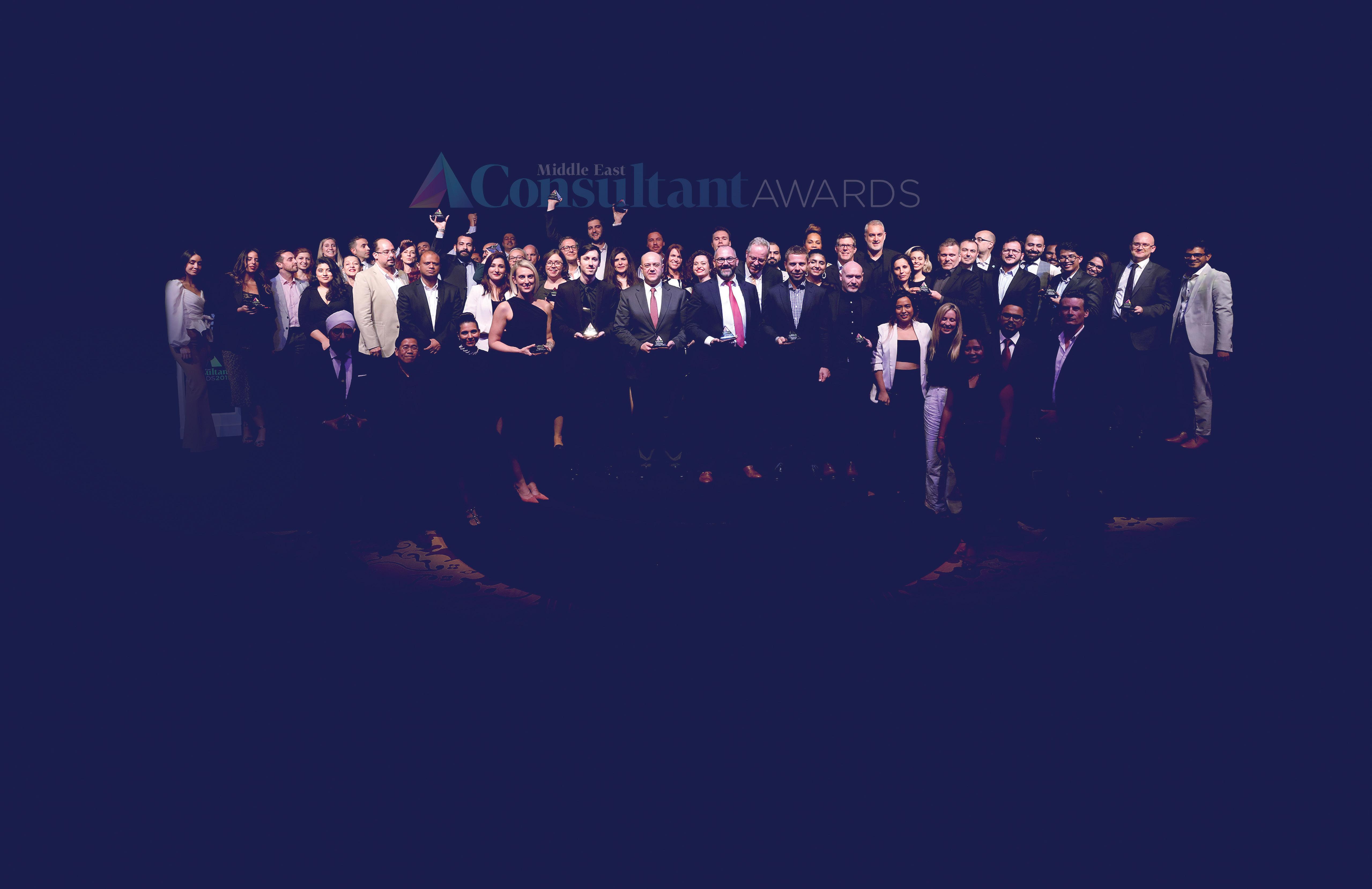

Get in touch Contact us Raising the bar and encouraging true competitive advantage Wednesday 22nd November 2023 THE RITZ CARLTON JBR / DUBAI / UAE Content Paul Godfrey +971 55 472 9717 paul.godfrey@cpitrademedia.com Sponsorship Andy Pitois +971 4 375 5473 andy.pitois@cpitrademedia.com

meconsultantawards.com © 2023 CPI Trade Media. All rights reserved. Scan here Nominate now PRESENTED BY PRESENTED BY SUPPORTING PARTNER SUPPORTING PARTNER SILVER SPONSOR SILVER SPONSOR PRESENTED BY 2023 Event Partners Nomination deadline: 31st October, 2023 st
Ben Jackson, Head of Project and Development Services, Middle East & Africa, JLL.
en, is there a key initiative from JLL that’s helping to bring those digital aspirations closer to reality?
“Well, we are building”, says Ben Jackson, “a city-wide Digital Twin. This is, in reality, the world’s first comprehensive digital real estate data mapping of a complete city; at its heart, it’s essentially all about mapping real estate market data to a 3D environment allowing users to interrogate the market in order to make better formed development decisions. In its current state, the Digital Twin enables us to quickly answer some of the key questions when analyzing development. For example, our key questions might include: “how many units are there in this community?”; “what are the unit types?”; “what size?”, “what’s the occupancy”, “what is my current supply in the market? and so on.
“Getting those answers is invaluable when trying to understand what product to bring to market and when. Once this base line is created, we can go one or two steps further and overlay other data too, e.g., tourism data; data from utility providers about personal and commercial usage; data from transportation hubs about travel and footfall; and - last but not least - data from GSM, telling you where people are and the frequency with which they go there. All of this contributes to helping you build an authentic picture of market behaviours and trends- and that in turn means you’re well-equipped to build the right kinds of properties in the right place.
“Just to put things in perspective, we have gathered information on 180,000 plots. We have used high-grade military satellites to scan the city and automatically extract data using AI technology across more than two dozen building categories. In fact, this is perhaps the most extensive digital mapping exercise ever undertaken from a Real Estate data perspective. This combined with multiple other data sources have allowed us to cleanse the data and reduce margin of error and increase data accuracy. Being able to firstly understand the exact amount, size and type of units, assets and buildings in any plot, community, or city gives us a great starting point.”
We then look at what is coming to the market to help us bridge the gap in the understanding of the supply and look at occupation levels across the city.”
“Sales volume, price and rental data is then overlayed on top of the city data, and we are then able to have a real time live view of the supply and demand for the city. This is a real game changer for JLL as it is starting to shape the way services will be delivered to clients in the future.”
“Where it becomes interesting and extremely powerful is when we can start placing our clients’ assets into the platform. Contextualizing the performance of their assets we can start to give greater insights around performance and also help us answer questions around not only their development decisions, but what to do with existing stock to maximize value. There could be a number of different solutions to maximize value or return on investment. But asset repositioning and retrofitting is one of the solutions that the tool can help guide us towards, where we are seeing a lot of activity in the global development market.”
“Value creation is the key driver in all of this. We sell value, lease value, construct value, and so on. Since data helps us make better decisions across the real estate mix, we’ll be much better placed to create more value for our clients and partners. In this sense, the Digital Twin is all about value generation. You have to remember that data
meconstructionnews.com September 2023
The real estate, development and consultancy sectors are constantly talking about the likelihood of a more digitised future, and the benefits that it will bring in terms of market knowledge and return-oninvestment. Yet what is actually being done here in practical terms?
18 | Close-up
We spoke to Ben Jackson, JLL’s Head of Project and Development Services, Middle East and Africa
“We create value”

September 2023 meconstructionnews.com Close-up | 19
is effectively information, and once you have it in the right quantity and the right detail, you have the ability to analyse that information to influence decision making. It won’t be long before these development decisions are automated.
BUILDING MARKET TRANSPARENCY
It’s often alleged, Ben, that the real estate markets throughout the GCC lack transparency; and that this has always been an impediment to attracting the right kind of overseas investment - after all, most of the ground-level investment we see is from other GCC markets.
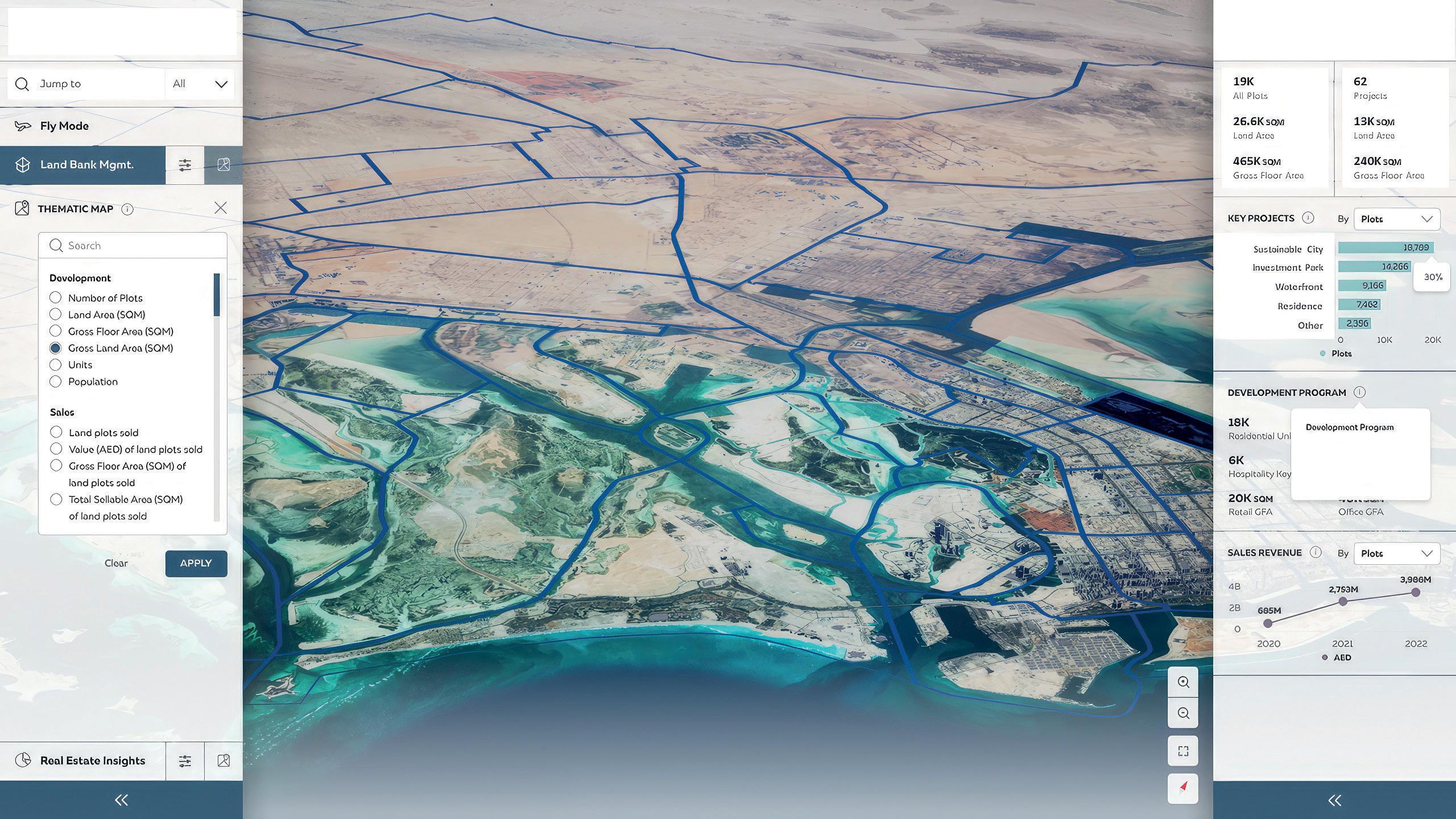
“I have often asked”, says Ben, “how do we make the market less opaque? Is this lack of clarity one reason why we don’t get more foreign investment? So, I feel that when the market in more transparent, it becomes more accessible for potentially interested parties.
“There’s no doubt: more data means greater market transparency, and that in turn means greater investor comfort.
Let me give you an example. How would better data around market rents change the market and propel it in new directions? What is the vacancy rate in a prime business district? It’s actually unthinkable that we don’t have precise answers, right? Of course, we have approximate knowledge from the market and from the sales and rental ledgers, yet if we had this information to hand, it would be an incredibly powerful tool. If you have more transparency and more comfort, then you have more investment. I think that the continual development of the Middle East real estate market is, to some extent going to rely on institutional overseas investment and being able to create this transparency through our Digital Twin platform will help this.”
CONSTRUCTION: SHARPENING THE FOCUS
Ben continues: “Then, there’s another factor: Construction. Remember, you are trying to build a product that you can effectively sell or rent.
September 2023 meconstructionnews.com
20 | Close-up
We have used high-grade military satellites to scan the city and automatically extract data using AI technology across more than two dozen building categories. In fact, this is perhaps the most extensive digital mapping exercise ever undertaken from a Real Estate data perspective”
Complex skyline information can be comprehensively captured and assessed by new-era Digital Twin technology.
Once we have the data about the real estate products that we should be bringing to market and an understanding of the specification: the type, the size, star rating, amenities, locality and adjacencies and what it can be sold or leased for, we then need to understand cost.
“In the pipeline for our Digital Twin we have a cost estimation calculator that is fed from the market “Hot Rates” collected from all the projects JLL tenders to contractors. This allows a development manager to very quickly undertake a high-level feasibility and give a stage one go-no-go.”
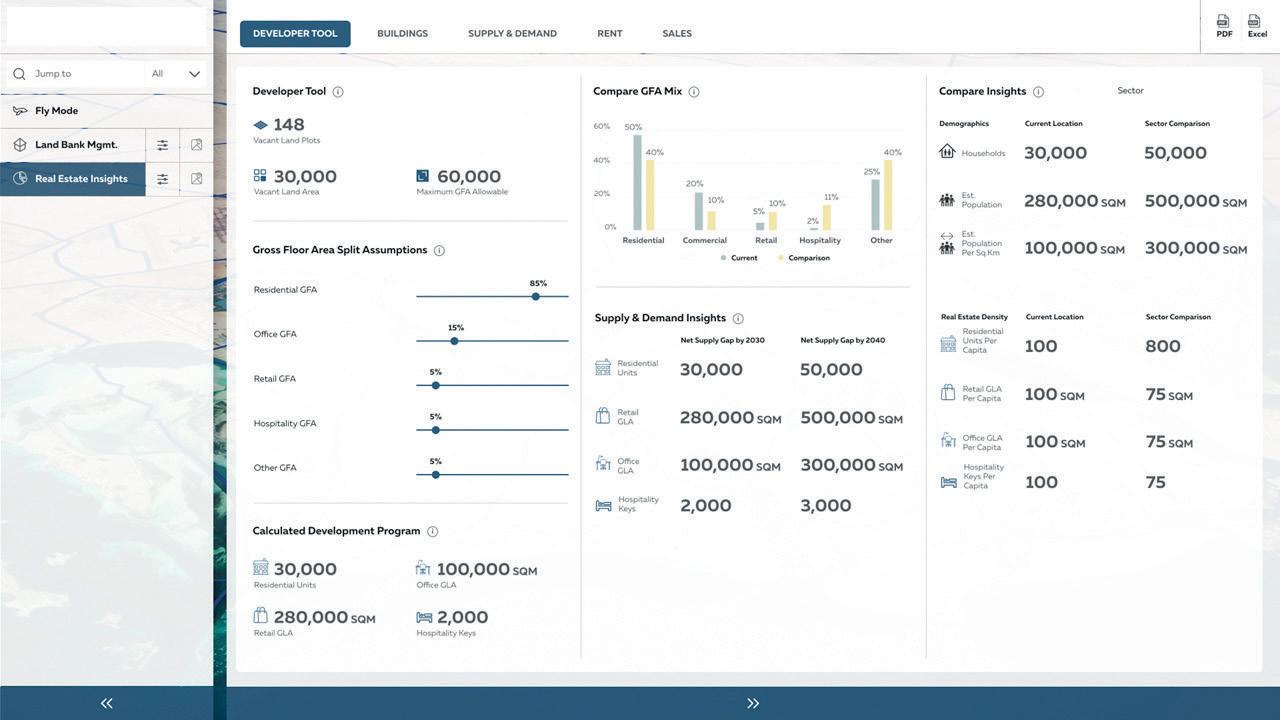
Within the front-end 3D environment, we have the ability to store all types of data, including GIS plot coordinates, affection plans, utilities information and drawings. What this enables clients to do is to access this information in an extremely easy user interface – costing and budgeting can then
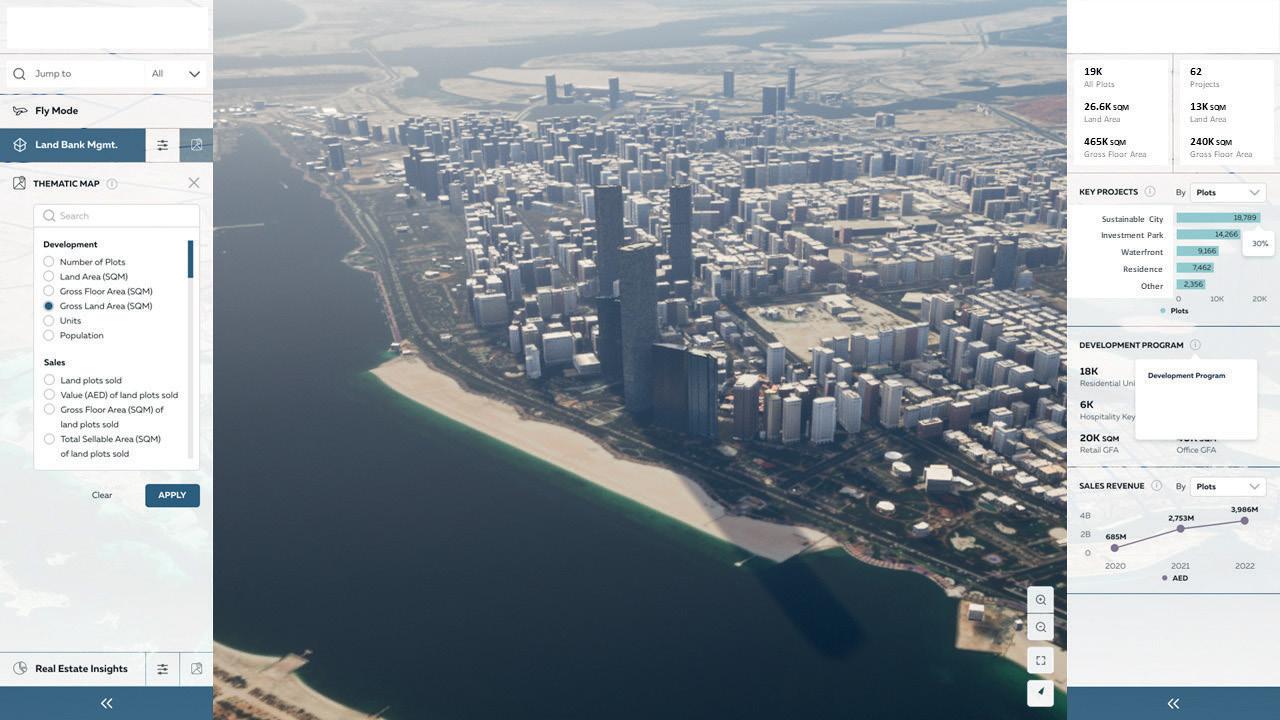
continue to take all the anomalies out of the equation.”
Due to the navigation hierarchy in the way we have structured data there is an opportunity for developers to then feed in the construction cost and program data. For those entities who develop large portfolios this data gives them the ability to have an accurate understanding of induvial projects or their entire portfolios construction performance at the click of a button. In the future this will develop into “drone to 4D BIM” representation within the 3D environment within the game engine of the platform.”
THE SUSTAINABILITY DEBATE
Is there another level of data opportunity here, too, whereby we can collect figures about energy consumption, and who is doing best in terms of energy conservation, commitment to New Energy principles, net zero, and so on?
“Yes”, replies Ben, “There is the energy and sustainability perspective too, which is front and center for us at JLL. IOT integration is in the development pipeline. Linking smart building technology and BMS systems into the platform is the next step. Understanding true operational cost along with development cost and revenue will give us a full picture of asset value for our clients and energy cost is high on the agenda.”
Imagine if you are one of the developers, with 20,000 properties; you have all these assets that can be digitised and put into a Digital Twin. You would then be able to see the energy performance of every asset in the portfolio. This would be an incredible opportunity for cost savings and narrowing energy discrepancies. You could proactively re-fit properties or know exactly where to direct your efforts when targeting savings though energy reductions.
“Or let’s look at it from an even wider perspective. Imagine that the government supports this initiative on a broader level and provides a microprocessor to every home and every property. The industry would then be able to see exactly how different zones perform - and if you are a landlord, you can then ask: “why am I burning through all this energy, when others aren’t?”
“In reality, this is all about optimising performance. We can use data to make better-informed decisions around property planning, and then in turn, data can help us build better and more efficiently.”
GETTING THE DATA
So, Ben, is there going to be a ’lightbulb moment’ when everyone starts waking up to the benefits of data and suddenly
September 2023 meconstructionnews.com Close-up | 21
Comprehensive data read-out facilitates logistical, commercial and demographic planning.
contributes massively to the communal data pool?
“I don’t think so. It’s more a process of accruing the data organically, but the concept of the Digital Twin is massively helpful in speeding up the data acquisition, of course.
“We are extremely careful about ensuring our clients data is protected but then much of this data already exists and it’s a matter of centralizing the data. The challenge for us is how to automate this data and keep it live. But when you think about it, much of the sales and leasing data is available and in the public domain. Then it comes down to building engineering performance, including MEP systems, façade performance etc. This is where the developer community should come together so that the industry can move towards a greener future together.”
“In fact, what this does is open up transparency on the supply chain and highlight systems and materials which are not performing optimally. It’s an interesting area for future thinking, as realistically, developers on a common platform needing common retrofitting requirements can leverage economies of scale to buy more cost effectively for their upgrades if required.”
“It goes without saying that we are naturally going to acquire data as it comes off our various trading processes; but the reality is, we are in an environment where none of us are very good at sharing dataand need I say, it’s all going to take much longer if we are going to stay in our silos. But a ‘data explosion’? No, it’s unrealistic at the moment.”
CITIES ‘BUILT TO ORDER’?
Is there also another, larger, opportunity here, whereby Digital Twin tech can help us plan, re-orient or create complete cities?
Ben believes there is. “The right data can help us deliver the best-suited urban communities; the more data we have, the closer we can come to the ideal scenario of a complete urban planning.”
In our current roadmap we have built a function whereby we can drop massing studies and masterplan BIM models into the urban 3D environment which allows our clients to view their masterplan in context”
“The next stage is to develop the ability to run the real estate modeling assumptions and see what happens to the modelling data when placed in the different context – so for example – how much of the predicted demand has it absorbed? Where does it sit in comparison to the neighboring unit prices? How does it work with the community amenities? And a whole host more.
“Naturally, what we will do next is to incorporate generative AI software into the platform. This will allow us to build out multiple massing studies and floor plans based on the existing supply and demand data, but we will also be able to add parameters such as building restrictions, sight lines, planning guidelines, building code, cost data etc. I think when that happens it will be a true game changer.”
But to answer your question – I think yes urban cities and environments can be design and modelled to the highest best use through powerful data driven platforms, generative design and AI. However, I do believe, and as a trained architect, that the output of this should form an incredibly well developed, development brief. It is then for the architect to refine the outputs
and bring the aesthetic and the human centric touch to the development, however big or small.”
“We already have the starting point for this with the Digital Twin. It gives us the platform to add data, augment it as necessary and create a fuller picture. Armed with this capability, you can be very proactive and get on with building the most appropriate type of assets that are best for the market.
NEXT STEPS…
Ben continues: “Let’s not forget another angle, too. With the IOT sensor data, we would also know what is the most effective arrangement of space. If we take the office or retail for example, understanding people’s preferences in location or working style can help inform how we design in the future.”
“Or let’s take it even further. Non-realestate data is the next element we will be looking at. If we can bring in Visa and Mastercard data, you will then see which shops are making the most revenue, and whether this is location-dependent, and therefore, how much should you charge for rent in those areas? This also allows you to be proactive, and see what product you need to build in the first place and which areas you need to be build it in. Uber and Deliveroo driver data can also tell us a lot about how certain communities work and demographics. It will also help us better answer questions in the e-commerce space for logistics and warehousing. So really the opportunities are endless. “This is can all be automated, it is instant, and it is all digitised.”
Our objective is to create a complete, real-time simulation of the real estate market so we want to work out ways to visualize and analyze data that touches real estate. This will help us create sustainable long-term value for our clients, resiliency for the Middle East and the best place to for people to live, work and play.”
Quite simply, it means we’re much betterplaced to get on with our core objectiveand that means creating value.”
September 2023 meconstructionnews.com
22 | Close-up
This is all about optimising performance. We can use data to make better-informed decisions around property planning, and then in turn, data can help us build better and more efficiently”


© 2023 CPI Trade Media. All rights reserved. Content Paul Godfrey +971 55 472 9717 paul.godfrey@cpitrademedia.com Sponsorship Andy Pitois +971 4 375 5473 andy.pitois@cpitrademedia.com Complimentary Register Now Register for free and stay connected Tuesday 31st October 2023 HABTOOR GRAND RESORT JBR / DUBAI / UAE Providing real-world solutions to the challenges of gender bias and ethnic diversity in today’s construction sector. wicsummit.net PRESENTED BY PRESENTED BY PRESENTED BY SUPPORTING PARTNER SUPPORTING PARTNER SUPPORTING PARTNER SUPPORTING PARTNER SUPPORTING PARTNER BRONZE SPONSOR SILVER SPONSOR SUPPORTING PARTNER STRATEGIC CONTENT PARTNER
or entrepreneurs, do you see OverviewFX as leveraging a principal source of income, or is it more a useful key to providing extra, helpful funding as required?
“OverviewFX has two goals: providing traders with correct information and capital through OFP. OverviewFX has been rebranded in the last 12 months, becoming the first editorial website made by traders to allow traders to check the best brokers, prop firms, and trading news in real time.
“Traders also have the opportunity to use many instruments like free tools,
calendars and much more for free in the website to facilitate their daily operatives. About OFP instead, it today counts thousands of full-time traders from all around the world.”
The Trader’s Advantage

How would your life - and perhaps your business’ fortunes too - change if you were able to be a competent and successful online trader, and did so with the help of an expert, third-party management package?
Middle East Consultant speaks to Ruggero Danielli, Co-Founder of OverviewFX, about potential gains, market-making information and the best in online trading…
Ruggero Danielli is Co-Founder of OverviewFX.

What kind of online training package do you provide, and how comprehensive is this?
“OverviewFX also provides training packages. However, we are still rebranding them and will go out to the public in the next 6 months. Our goal is to give traders firm knowledge that will allow any trader to be long-term sustainable in the market.”
Where did you first get the idea to set up a ‘third party’ online trading tuition package?
“The trading world is growing daily, as is the confusion and the fake news around it. Our main goal was - and still is - to create a safe environment for traders to learn, be founded, and be informed about the trading world in real time.”
Is OverviewFX regulated by the necessary and relevant financial authorities?
“OverviewFX provides genuine reviews of only those brokers that are fully regulated. This will reassure clients that, should they encounter any problem, they can send a complaint to the regulatory body.”
What markets does OverviewFX train newcomers to trade in, and what investment sectors are favored?
“We have been in the industry for many years; our community knows how we operate. Our transparency gave a chance to many people that were interested in trading to take a chance and enter this world. The Forex market is the biggest in the world, and we can notice that most of our funded traders and students trade it.”
meconstructionnews.com September 2023
24 | In Practice
Is there a minimum trading sum, and if so, how much is it?

“OverviewFX is free to use; on the other hand, OFP provides capital from 5k to 200k with a cost per account from £50 to £1000.”
Do you work by a ‘subscription’ model, or a one-off, upfront fee?
“OFP does not work on a subscription model but is just a one-time fee.”
If you don’t charge a commission, where does your income come from?
“OFP earns money if the traders make money. The trader will keep 80% of the profits, while OFP the 20%”
Do newcomers have to upload a new suite of software, or a trading app of some kind?
“On the funding site, OFP provides a
unique dashboard where traders can see their progress over time, watching in realtime if they have taken a right or wrong decision. On the other side, OverviewFx has everything detailed on the website, and those interested in the educational side will have to make a login through the website.”
Tell us about your vision for the company and where you see it headed?
“OverviewFX aims to become the leading company in the information sector around the trading world. Conversely, OFP wants to become the world’s leading prop firm.”
Are you an experienced trader yourself; perhaps you can ‘set the scene’ about your own background and career to date?
“Trading is not an easy career, but for sure,

one of the most challenging and profitable. Over the years, I changed a lot; I started with the idea of becoming the best trader in the world, to be surroundedd by almost 40 people who want to make the trading environment a better space. During the years, I have been lucky to meet the right people at the right time: first, the guy who taught me how to think differently in the market when we trade; then Marcello, my business partner and friend, with whom I started the company; and then David, the COO of the company. Both in the business and the trading side, we had a lot of ups and downs that helped us become better traders and entrepreneurs.
“Today, I would say that one of our key points is that we are no longer just colleagues, but friends who try to solve problems in the most analytical way in order to arrive at the best solutions both for the companies and for the traders.”
September 2023 meconstructionnews.com In Practice | 25
WHAT PRICE URBAN FUTURE? A BIOPHILIAC
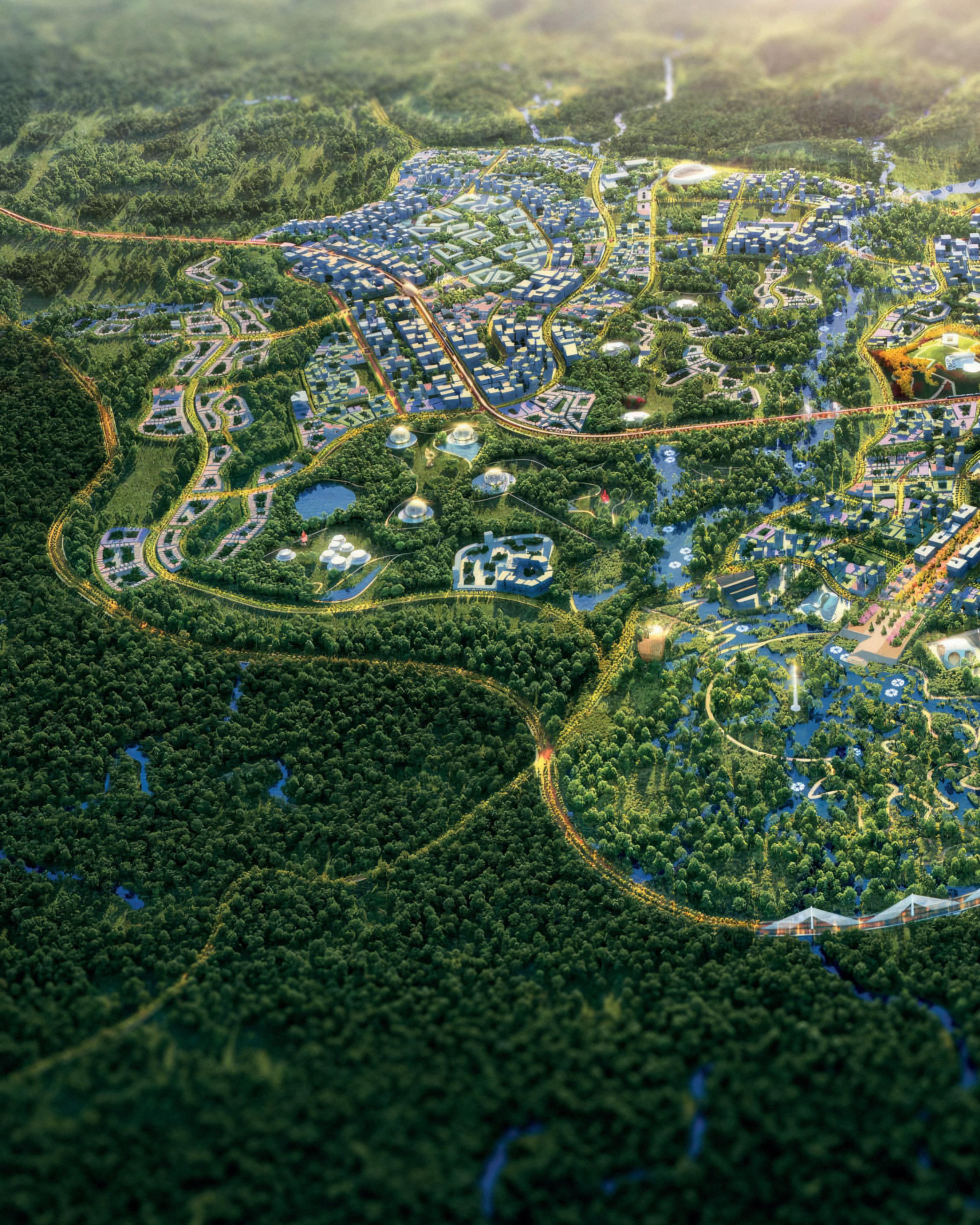
meconstructionnews.com September 2023 26 | In Practice
Right now, there is more attention on city-building than, arguably, at any other moment in human history - with more than 2.5bn people set to migrate to cities before 2045. These dynamics are giving rise to many movements concerned with making the urban experience more sustainable, more varied, and simply more pleasant. Hence, recent moves to create a focus on ‘naturebased infrastructure’ (NBI). Middle East Consultant spoke to IISDthe International Institute for Sustainable Development - to find out more


September 2023 meconstructionnews.com In Practice | 27
ne of the reasons that urban planners are so concerned with creating brand new, one-stop cities - like Telusa and Nusantara, for example - is that the existing cities around the world are struggling to provide people with the levels of infrastructure that allow them to get around, go to work, and enjoy their leisure.
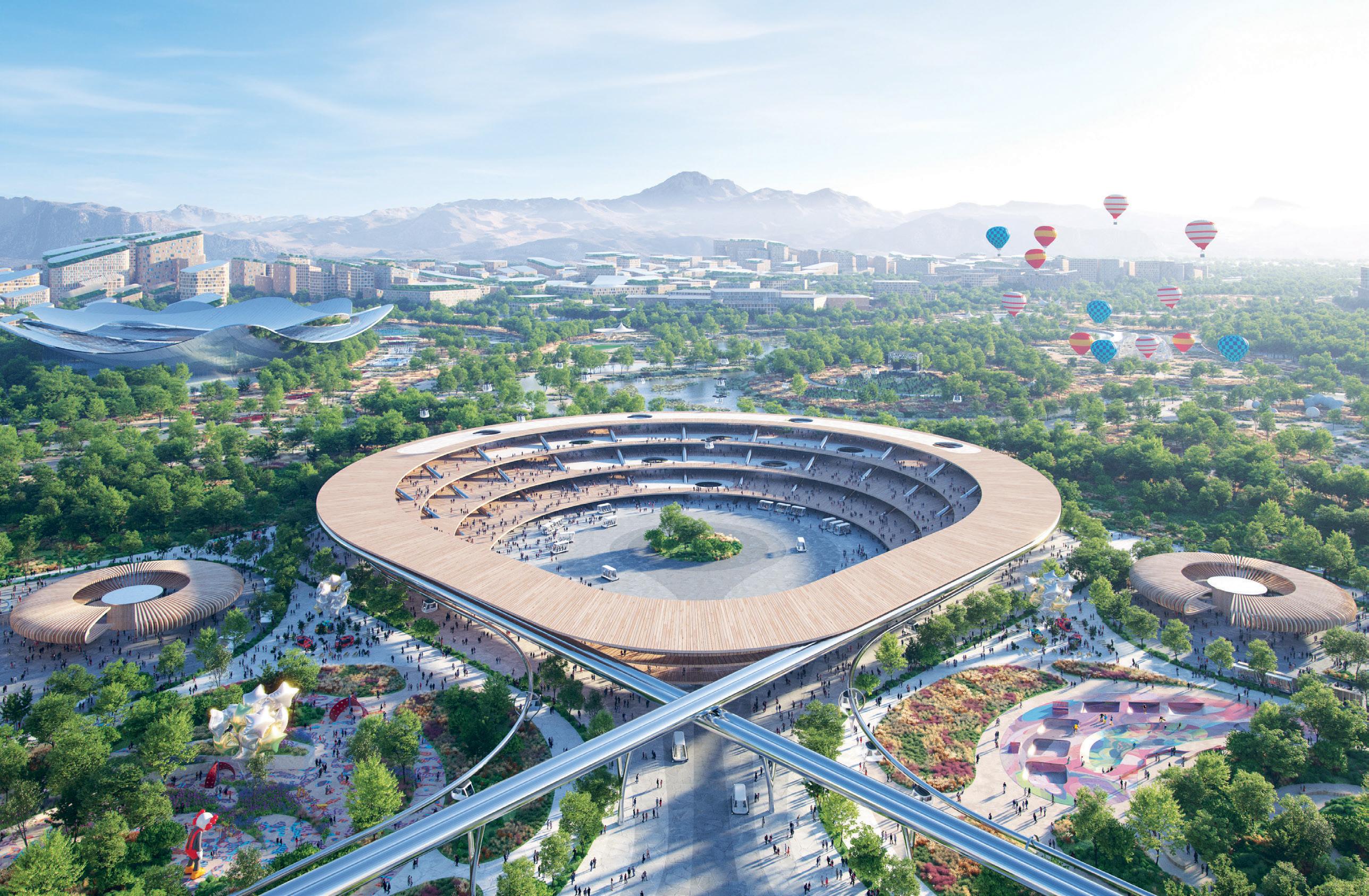
One of the ‘golden rules’ of urban planning, for example, is not to repeat the same mistakes: and so, there are all kinds of opportunities for ‘nature-based infrastructure’ (NBI), which represents something new, fresh and vibrant. At least in principle, it can deliver cost-effective, climate-resilient infrastructure services and, as a spin-off, it generates a wealth of co-
benefits for city residents and visitors, such as reduced air pollution and improved wellbeing. So, it should therefore go without saying that to maximise the benefits of NBI, the value of nature must be at the heart of strategic, cross-sectoral urban planning.
INFRASTRUCTURE IS A TWO-EDGED SWORD
Of course, infrastructure is a key enabler of sustainable development. It provides people with the services they need to thrive while also protecting the environment from human impacts, such as pollution. Yet let’s not forget that at the same time, urban development (if done unsustainably) is one of the main drivers of biodiversity loss and climate change. In cities, infrastructure needs are particularly high because urban areas are challenged by massive population growth and increasing climate impacts. However, because it plays such a central and crucial role, the reality is that ‘greening’ the infrastructure in the right way can foster sustainable cities. In other words, for cities to be sustainable, the urban infrastructure must also be sustainable.
The United Nations Environment Programme (UNEP) defines sustainable infrastructure systems as being “planned, designed, constructed, operated and decommissioned in a manner that ensures economic and financial, social, environmental (including climate resilience), and institutional sustainability over the entire infrastructure life cycle.”
Building with - rather than against - nature has direct benefits for cities. So, naturebased infrastructure (NBI) includes areas or systems that harness nature to provide infrastructure services for people, the economy, and the environment. Examples of NBI include natural ecosystems, such as forests, mangroves, wetlands, and grasslands. But NBI can also involve engineered or ‘grey’ structures that incorporate naturebased solutions, like rain gardens, biophilic
meconstructionnews.com September 2023
28 | In Practice
Nature-based infrastructure has the twin benefit of providing park and recreational zones, while cooling ambient temperatures and reducing hot-spots.
walls and green roofs, for example. There are three important ways that NBI helps make cities more sustainable:
1. NBI delivers cost-effective and climateresilient infrastructure services, such as flood protection, water filtration, and temperature regulation. This helps provide people with the infrastructure they need for their safety, well-being, and livelihoods.
2. In addition, NBI offers valuable cobenefits for communities and the environment. For example, NBI can support climate change mitigation and adaptation efforts, such as by sequestering carbon. These types of infrastructure can also provide habitats for threatened species, support people’s livelihoods, and offer space for recreation.
3. Building with nature also enables investments in other sustainable infrastructure, in particular, in the areas of mobility, water, and energy. For example, urban green spaces help reduce city temperatures, which in turn reduces heat-related efficiency losses from power systems and supports a stable energy supply from renewable sources.

A COSTLY OPTION?
So, NBI provides infrastructure services, mitigates costs from increasing climate impacts, and generates many added benefits for citizens. But at what cost? Isn’t this set to be an expensive process? A new International Institute for Sustainable Development (IISD) report finds that if these benefits are taken into account, NBI
in cities is, on average, 42% cheaper and creates 36% more value than relying only on grey infrastructure to provide the same infrastructure services. IISD case studies show that for each USD1 invested, naturebased infrastructure in cities can generate up to 30 times that amount in returns for society, making investments in urban nature economically viable. This, however, implies that leveraging the benefits of nature for sustainable cities requires strategic urban planning with NBI at its heart.
To make the most of the benefits of urban nature, NBI needs to -
• Become a central part of city planning, project assessments, and financing strategies.
• Planners, policy-makers, and stakeholders need to be open enough to consider a broad portfolio of infrastructure investments and maximise their mutual benefits.
• This means developing cross-sectoral, strategic plans for sustainable urban development and evaluating which NBI investments best support the city’s infrastructure and sustainability objectives.
One ray of light here is that there is no doubt that cities around the world are working hard to create inclusive, healthy, and sustainable, pollution-free environments for their residents. Many are committed to ambitious climate goals and to protecting urban biodiversity; we shouldn’t overlook key initiatives like the ‘Global Covenant of Mayors’ and the ‘CitiesWithNature’ movements.
Of course, we are still faced with the ‘twoedged sword’: just as the possible options are better and more diverse than ever, so are the challenges that much more intense. There is no doubt that public budgets internationally are under near-breaking-point pressure, and the list of mounting global crises is currently getting worse and more immediate. What more pressing set of reasons, then, for embracing the benefits of NBI and its synergies with urban infrastructure? After all, it’s one route that truly does open the door to the fully sustainable cities of the future.
September 2023 meconstructionnews.com In Practice | 29
Building withrather than against - nature has direct benefits for cities. So, nature-based infrastructure includes areas or systems that harness nature to provide infrastructure services for people, the economy, and the environment”
URBAN PLANNING & TOMORROW’S WORLD
leading Malaysian urban design studio, PEQ Consult, about these seven options and what they actually include.
But, first things first. The process of building and designing urban areas is known as ‘urban planning’. The usage of open space, air, water, and the built environment, which includes buildings, transportation, economic, and social functions, are included in urban planning. Most often than not, an urban plan is used as part of a broader city plan.
Urban town planning encompasses a wide range of city-life features, including new and pre-existing land, buildings, roads, public spaces, transit, economic growth, infrastructure, and the environment, to name a few. Below, we’ve grouped these elements into distinct conceptual categories.
These are frequently referred to as types of urban planning. Still, it’s crucial to remember that they’re not mutually exclusive - a unified urban plan should encompass many, if not all, of the areas listed below:
1. STRATEGIC URBAN PLANNING
and - perhaps most strikingly of all - in many South American states.
t’s a truism that there has never been so much emphasis on urban planning as there is right now. While in the USA, UK and western Europe, the 1960s and early ‘70s were peak times for reconsidering the growth of cities and the provision of numerous ‘new towns’, the urban explosion has now spread to the far corners of the globe.
City-building and city expansion is now part of a dominant agenda in Saudi Arabia, Malaysia, Indonesia, Bangladesh, China
The events created by Middle East Consultant - for example, the Future of Architecture Summit - have often focused on aspects of contemporary urban planning, particularly the debate as to whether planners should opt for the ‘15-minute’ city - boasting high levels of accessibility, pedestrian access, and so on - or opt for a futuristic world of supertall structures offering the attractions of space-saving ‘vertical cities’.
It’s perhaps important, however, at this stage, to take a sobering step backwards and consider that there are basically seven types of urban planning - and between them, these comprise the sum total of what it’s best and feasible for planners to do when trying to expand our urban horizons. Middle East Consultant spoke to
Setting high-level objectives and establishing preferred areas of development for a city or metropolitan region is the focus of strategic urban planning. A strategic plan, also known as a development plan, core strategy, or comprehensive plan, is the end outcome of the planning process.
The strategic plan’s objectives might include enhancing city transit, developing additional communal spaces, increasing inhabitants’ quality of life, and enticing people to visit or relocate to the city. This is usually the highest level of the planning process, and other planning elements will usually fit into this sort of plan.
2. LAND-USE PLANNING
Land-use planning is primarily concerned with law and policy, including the adoption of planning instruments such as governmental laws, regulations, rules, codes, and policies to impact land use.
meconstructionnews.com September 2023
30 | In Practice
In what is an intense and often anxious time for urban planners - when factors like sustainability, population density and re-purposing are all paramount - Paul Godfrey takes a detailed look at the seven key layers of urban planning and what they can each set out to achieve…

September 2023 meconstructionnews.com In Practice | 31
These planning tools address the kind, location, and quantity of land required to carry out various municipal tasks on a general level. They may also be used to zone or reserve land for specific uses, such as:
• Residential - refers to structures such as apartment complexes, single-family houses, and condos.
• Commercial - refers to structures such as retail stores and office buildings.
• Industrial - refers to manufacturing facilities and warehouses.
• Municipal - refers to structures such as police stations and courthouses.
Consultation with the community and key stakeholders, as with other kinds of urban planning, is an essential aspect of land-use planning, in order to promote transparency and include diverse interests into the final plan.
Transportation, commercial, and industrial planning should flow naturally into the strategic plan, if and when it’s to be communicated properly.

3. MASTER PLANNING
Master planning is often used for greenfield development projects or construction on previously undeveloped land - where the developer is starting from scratch, rather than changing existing buildings or areas.
This style of urban planning predicts what a particular location will look like in the future and what it will take to get there.
To make the project practicable, urban planners must consider the needed zoning (from the land-use plan) and infrastructure, such as residential and commercial property, transit considerations, road placements, and so on.
They must also determine where community facilities, schools, parks, and other urban amenities will be located. Again, communicating with landowners and government organisations who will be affected by the proposal is critical.
Town planners may also need to hire experienced consultants to gain vital knowledge and insights, ensuring that
the design incorporates all possible perspectives and guarantee that the finished area is successful for years to come.
4. URBAN REVITALISATION
Urban revitalisation, in contrast to master planning, focuses on improving regions that are in decline. The precise definition of a declining area varies per city - for example, parts with a high number of failed companies or population growth that is static or falling.
Repairing roads, expanding infrastructure, cleaning up pollution, and
meconstructionnews.com September 2023 32 | In Practice
There are basically seven types of urban planningand between them, these comprise the sum total of what it’s best and feasible for planners to do when trying to expand our urban horizons”
adding to parks and other public spaces are some of the revitalisation strategies used by city officials, depending on the main reason for the decline.
Residents and business owners frequently offer insights that may assist in influence and adjust planning efforts. Therefore, community participation is crucial with this urban planning idea.
To achieve the upscale apartments that are desired, it may be necessary to convert the land use from industrial to residential, or to incorporate environmental planning to clean up any issues from less successful prior-use cases.
5. ECONOMIC DEVELOPMENT
Economic development is the process of finding areas for expansion to encourage more financial success inside a community, particularly by luring businesses to construct or relocate their offices there.
Following that, a logical dynamic can take place –
• Businesses recruit local employees and boost commuter traffic to the new location.
• Increased exposure and spending in the neighborhood will result from more employees eating lunch at local eateries, obtaining fuel at adjacent petrol stations, and stopping by local grocery shops on their way home. Because an economic development department may be separate from a municipality’s planning department, it’s critical to assist that group in navigating Land Use Plans, Master Plans, and Infrastructure Plans to verify that any development proposals are feasible. It will, of course, be necessary to collaborate with the raft of environmental plans.
6. ENVIRONMENTAL PLANNING
Environmental planning is a type of strategic planning that focuses on longterm sustainability.
Air pollution, noise pollution, wetlands, endangered species habitats, flood zone vulnerability, and coastal zone erosion, among other environmental issues affecting the link between natural and human systems, are all considered in this category of urban design.
Along with master, revitalisation, and infrastructure plans, environmental plans must similarly be prepared in great detail. While this linear process may seem complicated, it will be preferable in the long run if the nexus of ideas work logically together and flow in a ‘cause and effect’ dialogue with each other.
7. INFRASTRUCTURE PLANNING
Infrastructure planning is concerned with the basic facilities and processes


that serve a city and its residents and how such facilities might support the strategic plan’s aims. This category of urban planning entails:
• Public works infrastructure: This includes water supply, sewage, electricity, and telecommunications.
• Community infrastructure: This includes schools, hospitals, and parks.
• Safety and transportation: This includes roads, police, and fire stations.
‘THE DIAMOND PRINCIPLE’
Architects often talk about a ‘Diamond Pirinciple’, whereby these seven different layers of planning are actually facets of one linked and unified whole.
As the above summaries show, proper planning takes a significant amount of effort, and far from the architect, designer and planner working in isolation, will demand close liaison and work with a registered town planner and town planning consultant.
Note as well that many combinations and clusters of these planning operations can take place independently of each other; it will be relatively rare to have a ‘Brasilia’ or ‘Nusantara’ scenario, when an entire cityscape can be created from scratch. Rather, the challenge is more likely to be how best to upgrade aspects of an existing small or intermediate community and make it good and ready for targeted population drift and planned economic revitalisation.
September 2023 meconstructionnews .com In Practice | 33
Even the most cursory look at urban infrastructure reveals complex, multi-level planning and design.
CHALLENGES OF NEW GENERATION CITIES
n today's world, the rapid growth of urban populations is putting immense strain on cities and their infrastructure. As more people flock to big cities, policymakers and specialists face the daunting task of making these cities livable for everyone. This challenge becomes even more significant considering that by 2050, approximately 70% of the world's population will be living in urban centres, according to the United Nations. The need to create new-generation cities in Africa and the Middle East is crucial
if we are going to properly address the infrastructure challenges and ensure critical factors such as social inclusivity and economic opportunity. This article explores the key factors and innovative solutions required for infrastructure development in these regions.
THE RISE OF NEW GENERATION CITIES
The world is witnessing the rise of new generation cities, with 32 megacities - a megacity is a city of at least 10 million inhabitants - currently existing globally and an estimated 43 projected by 2030, mostly in Asia and Africa. These regions, however, are also the least resilient to catastrophic ecological threats. To overcome these challenges, new-generation cities must address various infrastructure aspects, including transportation systems, energy sources, waste management, and clean water and sanitation services.

September 2023
34 | Infrastructure
With the astonishing rise of the mega-city and the ongoing creation of completely new, purpose-built urban hubs, the challenges of infrastructure provision have never been more intense. Sameem Gaffar, Executive Vice President - Internationalization, Morgenthau Stirling, inc., investigates…
So, it follows that, to ensure the enduring success of new-generation cities, several key factors must be considered during the planning and development stages. These include -
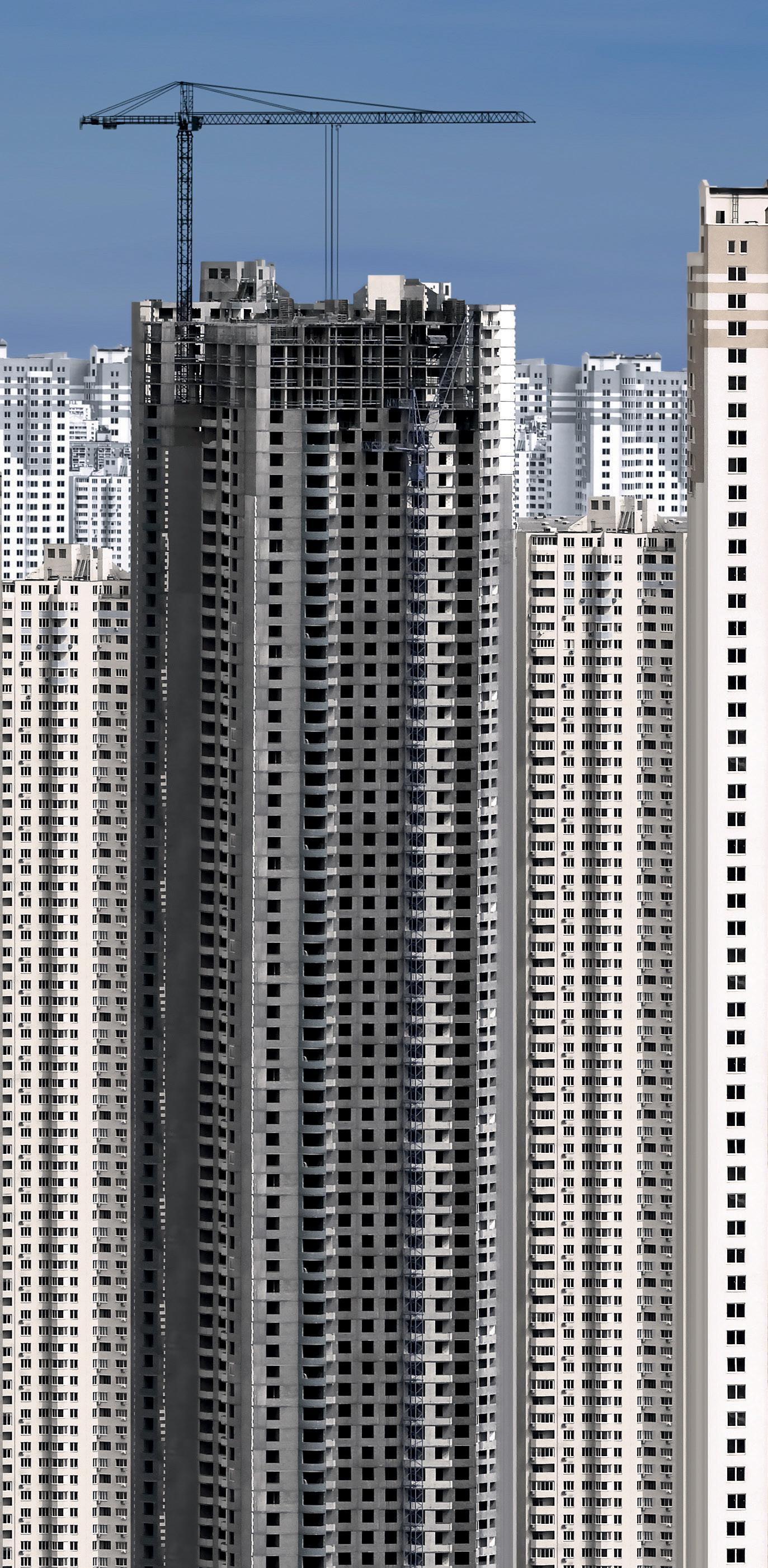

1. DESIGNS THAT CONSIDER FUTURE GROWTH
Designing cities that can accommodate future growth is crucial. A well-crafted Masterplan is essential, but it should also have a calibration mechanism to accommodate potential changes and prevent the project from becoming obsolete. For cities like Kinshasa, the capital of the Democratic Republic of the Congo (DRC), and Dar-es-Salam in Tanzania, which are projected to experience significant growth, a combination of retrofits and new infrastructure concepts is necessary. Harnessing the potential of InfraTech (Infrastructure Technology), which is projected, for example, to be heavily used in the future city NEOM in Saudi Arabia, can provide innovative solutions to accommodate growth and ensure sustainable development. Smart parking solutions and accommodating bikers and low-emission vehicles should also be part of designs to alleviate congestion and ensure traffic fluidity.
One compelling case study in this respect is the city of Kinshasa, the capital of the Democratic Republic of Congo. With a projected population of 29 million by 2050, Kinshasa is expected to become the second megacity in Africa. The Government of the Kinshasa Province has created a Special Council for the promotion of the Master Plan for the Development of the City of Kinshasa (PDTK), developed by JICA (Japan International Cooperation Agency) to attract expertise and investments into the city’s development.
Ms. Rebecca Holding, who leads the Council, explained that the main challenge
September 2023 Infrastructure | 35
New-era cities are currently being built at incredible speeds, but bring with them a host of complex infrastructure issues.
is that Kinshasa was built for 400,000 inhabitants in the 1960s and, today, its 20 million people inhabitants are packed in the same downtown area, using the same infrastructure, including water, sewage, electricity. “Nothing has evolved; while 70 percent of Kinsh-asa is still bare, undeveloped land, industrial, commercial and residential activities keep popping up in the original congested downtown,” notes Ms. Holding.
The Master Plan aims to resolve this issue by determining the city's new framework and implementing 117 new projects estimated at $32 billion. Some of the innovative ideas include implementing a different model for transport infrastructure - using the water-ways and river transport - as well as smart road traffic management.
Rebecca Holding explains: “New sub-cities will be built to stretch the communities, and decentralise the industrial parks. This will help address the massive shortage of housing in the city. These represent opportunities for foreign investments, as DRC is asset-rich but lacks funding to meet those investments requirements by itself. The main incentive is that DRC is on a trajectory of poliltical stability.”
2. A SUSTAINABLE FUNDING PIPELINE
Securing a sustainable funding pipeline is essential for infrastructure development. To attract private capital investment, measures must be taken to address regulatory, governance, and political risks. Currently, investment in infrastructure falls short of the required levels, with an estimated $15 trillion needed to keep pace with current trends. Additionally, the challenges posed by a changing climate may further increase the required investments. Overcoming political and economic risks, and providing security and guarantee mechanisms, can encourage funding from development funds, private wealth, and other sources.
3. PROJECT READINESS
Currently, there is a lack of funding and planning at the critical stages of project
preparation. Feasibility studies around capital projects that clearly articulate the viability of a project and the financial returns are sorely lacking. Far too many projects do not pass the initial stages of fund-raising for a lack of preparedness. At times, there is not equity in place by the local project owner to satisfy interested investing parties, compounded by the fact that there are inherent impediments for outflow of capital from these underserved regions, for instance when a SPV (Special Purpose Vehicle) is being considered. Governments need to revisit capabilities in this area and provide the necessary policy and legal framework, for instance, to ensure that PPPs (Public Private Partnerships) arrangements can be concluded safely.
4. GOVERNANCE & AGILITY
Efficient project management and governance structures are crucial for successful infrastructure development. Many urban development projects face cost overruns and delays, hindering their intended objectives and deterring potential investors. Implementing appropriate
governance structures, reporting mechanisms, and monitoring systems can help mitigate these challenges. The adoption of a Delivery Unit methodology, which ensures oversight and implementation of projects, can help de-risk projects, and ensure their seamless execution.
INFRASTRUCTURE CHALLENGES IN NEW GENERATION CITIES
New generation cities in Africa and the Middle East face several infrastructure challenges that must be addressed to foster sustainable urbanisation. These challenges include sustainability and resilience, digital infrastructure, healthcare infrastructure, waste management infrastructure, energy infrastructure, water infrastructure, and social infrastructure.
SUSTAINABILITY CHALLENGES AND RESILIENCE

Urban areas contribute significantly to greenhouse gas emissions, and without proper policies, these emissions will continue to rise. In turn, this will lead to increased global warming and associated damages. Cities like Jakarta, which is sinking at an alarming rate, showcase the urgent need for resilient infrastructure. Integrated smart solutions, such as realtime monitoring systems and floodresistant buildings, can enhance urban resilience and reduce the impact of natural disasters and climate change.
DIGITAL INFRASTRUCTURE
Digital infrastructure plays a vital role in enabling smart cities. In Africa and the Middle East, the development of digital infrastructure is crucial for connectivity, economic growth, and access to information and services. This includes the deployment of high-speed broadband networks, data centres, and the implementation of smart technology solutions.
HEALTHCARE INFRASTRUCTURE
It’s a truism that access to proper healthcare infrastructure is essential for the well-being of residents in new-generation cities. The
meconstructionnews.com September 2023
36 | Infrastructure
Sameem Gaffar, Executive Vice PresidentInternationalization, Morgenthau Stirling, inc.
COVID-19 pandemic highlighted the importance of robust healthcare systems. Investing in healthcare facilities, medical equipment, and trained professionals is crucial for providing quality healthcare services and ensuring the resilience of cities in the face of future health crises (which are sure to arise).
WASTE MANAGEMENT INFRASTRUCTURE & CIRCULARITY
Efficient waste management is vital for maintaining a clean and sustainable environment. New-generation cities should prioritise the establishment of waste collection systems, recycling facilities, and waste-to-energy plants. Public awareness campaigns and education programmes can also help change attitudes towards waste management and promote responsible waste disposal practices.
ENERGY INFRASTRUCTURE
Investments in energy infrastructure should focus on renewable energy sources, such as solar, wind, and hydropower. Smart grid technology can optimise energy distribution and consumption, promoting energy efficiency and resilience.
Utilising smart predictive analysis and real-time monitoring can further enhance the control and performance of energy systems. With the popularisation of Electric Vehicles (EVs), energy designs in smart cities should cater for charging ports, and recycling of batteries.

WATER INFRASTRUCTURE
Access to clean and reliable water supply is essential for residents' well-being. Newgeneration cities should prioritise water infrastructure, including water desalination, water distribution networks, and advanced Internet of Water infrastructure. Smart technologies, such as real-time monitoring and leak detection, can ensure the efficient and sustainable management of water resources.
SOCIAL INFRASTRUCTURE
Social infrastructure, including educational institutions, cultural centres, recreational facilities, and affordable housing, plays a
crucial role in enhancing residents' quality of life and promoting social cohesion. Governments and private sector entities should collaborate in the construction of social infrastructure to create inclusive and liveable communities.
CONCLUSION
Innovative solutions that integrate technology and sustainable practices are essential for the successful development of tomorrow’s cities. The definition and design of future cities will define how human societies evolve. By addressing various infrastructure challenges, including sustainability, digitalisation, healthcare, waste management, energy, water, and social infrastructure, cities can accommodate growing populations while preserving natural resources. Proper project governance principles, scalability, and phased implementation are essential to ensure the longevity and success of these projects. By embracing innovative solutions and integrating technology and sustainable practices, new-generation cities can create smart, resilient, and inclusive urban environments for the future.
September 2023 meconstructionnews.com Infrastructure | 37
Kinshasa is a 'sleeping giant' city slated to be a world top three within the next twenty years.
While not an end in themselves, certification programmes underpin adherence to a raft of preferred sustainability options.
CERTIFYING ‘GREEN’ HOSPITALITY
he United Arab Emirates, with Dubai often championing the changes, has experienced a significant increase of sustainable business practices during the past few years. It has made a shift from relying on non-renewable resources to prioritising sustainability in its economic and social development. This evolution was also fostered by the implementation of regulations and certification programmes, by investments in renewable energy and by the overall increased awareness of the need to protect the environment and promote sustainable practices in the entire region.
Now let’s focus on one key aspect here: certifications. These have become an integral part of the construction landscape and are also an important factor in the hospitality sector, too. What type of certifications will be most soughtafter by Management depends on the project objectives, the requirements, and the level of ambition and desire for global recognition. For example, Al Sa'fat, Estidama, and Barjeel certifications are usually preferred for local projects, while LEED, BREEAM, or EDGE (among others) offer global recognition. Another international standard that establishes
requirements towards a functioning environment protection management system is ISO 14001, which is not only specific to the construction industry, but rather relevant to organisations that wish to demonstrate their commitment to environmental management in their operations in general.
The demand for certifications is further fuelled by local regulations which play an important role, as they are constantly evolving in the UAE. They may require specific certifications or criteria to be met for certain construction projects.
DRIVING THE CHANGES
The driver behind many construction projects, and their quest for certification,
is often the hotel industry. For hotels, obtaining a sustainability certification might entail - and indeed, deliver - several objectives.
Firstly, it reflects the commitment of a hotel to support the UAE in achieving its environmental responsibility regarding the decarbonisation of the country according to the National 2050 plan and, now specifically speaking about Dubai, to the Urban Vision “Dubai 2040 Urban Master Plan & Sustainable Development”. Dubai, once more showing its commitment, will also host the United Nations Framework Convention on Climate Change COP 28 in December 2023.
The importance of these certificates and the commitment of the hotels are key
meconstructionnews.com September 2023
With so much discussion around sustainability, it’s often overlooked how elaborate a raft of provisions the UAE has already put in place - and the various benchmarks of certification which key brands can aspire to. No sector is more bound up in this ‘green’ debate than Hospitality - and here, Margarita Huaca, Engineer & Sustainable Development Expert
38 | Sustainability
- Business Development, ENERNOUVA, assesses the power of benchmarking in this key contributor to the UAE economy…

September 2023 meconstructionnews.com Sustainability | 39
factors for the promotion of sustainable tourism, because Dubai has become a worldwide tourist destination - and allied to this, it is a priority to maintain the biodiversity of the region and to achieve a reduction of the environmental impact caused by numerous building initiatives.

Certification also ensures that hotels comply with regulations related to energy efficiency and sustainability by implementing measures to reduce their environmental impact and promote responsible practices. It provides credibility and validation to the organisation, reinforcing its reputation with customers, investors and the community at large, demonstrating the hotel's commitment to sustainable practices and policies.
By adopting such sustainable practices, organisations also seek to improve their operational efficiency and reduce costs in the long term. This is also reflected in an improved image and attracts travellers who value environmental and social responsibility. It makes it easier for travellers to find and book accommodations that match their values and preferences.
Certifications set standards for evaluating a building's sustainable performance, and energy efficiency is a key component of
these standards. When it comes to already existing buildings, retrofit projects are an effective strategy for improving the energy efficiency and meeting sustainability certification requirements.
THE ROLE OF DATA
When looking into efficiency and performance, more and more companies realise the importance of obtaining information from constant data monitoring and tracking. This is essential to evaluate the systems in place (e.g. waste management, water management) and to identify any points for improvement and to adjust operations to maximise efficiency and minimise long-term environmental impact. It is also good for documenting data for reporting and KPI purposes (e.g. for waste management: keeping a clear record of what is recycled and what goes to a landfill).
Of course, the use of renewable energy plays an important role in generating part or all of the needed energy. This significantly
improves your energy efficiency and reduces your carbon footprint.
WORKING PROACTIVELY
Certifications as part of building management are effective tools to proactively promote practices and standards across multiple aspects of building design, delivery and operation. For example, as per the Dubai Green Building Regulation in 2010 (currently called Al Sa'fat) which has been in place since October 2020, buildings must meet strict energy efficiency standards. That is, they must be designed and constructed with systems that minimise energy consumption, such as LED lighting, efficient HVAC systems and hot water systems, among others.
These certifications encourage technological innovation and an environment friendly selection of building materials, for example those with low VOC (volatile organic compound) content or from renewable or recycled sources.
Hotels in Dubai are supported by the Dubai Sustainable Tourism (DST) initiative which is an initiative launched by the Department of Tourism and Trade Marketing (Dubai Tourism). It is a government entity that promotes sustainable practices in hotels.
meconstructionnews.com September 2023
40 | Sustainability
We are increasingly seeing the rise of hotels and hospitality units with a clear commitment to sustaining and building the ecology of their surroundings.
To obtain this recognition they must meet standards that include the promotion of environmental conservation and the adoption of sustainable practices as well as water and energy management among many others.
DST sets standards that address a wide range of areas, from waste management with recycling hoods, to energy efficiency and hotel retrofits, to water conservation.
Many luxury hotels are also directly involved with active conservation of local wildlife, such as supporting or creating a turtle sanctuary, or by sponsoring dolphin interaction in a responsible and supportive context.
And of course, the flora is also very important: look, for example, at the Mangrove conservation in Abu Dhabi. These ecosystems, which are among the oldest in the region, are vital for biodiversity and flood protection.
Many sustainability certificates, especially those that focus on reducing carbon emissions, are linked to carbon offset programmes, eg, as part of the corporate social responsibility CSR programmes. Popular protocols used here include “planting trees” directives that more and more hotels are incorporating when they assess their environmental impact on carbon emissions. For every ton of carbon emitted, a certain number of trees are planted, which absorb carbon dioxide from the atmosphere. The number of planted trees can then be included in the carbon footprint calculation. These programmes not only contribute to the reduction of carbon emissions, but also have a positive impact on biodiversity and air quality in a region that faces unique environmental challenges due to its desert climate.
All these aspects are also taken into account by hotel booking agencies, which have responded to this growing demand by including information on hotel sustainability practices on their platforms, for example, via incorporating specific search filters that align with the preferences of the environmentally-conscious traveller.
Of course, having certificates has many advantages as it recognises the efforts and enhances the reputation & attractiveness of hotels to the growing number of travellers coming to the region.
REPUTATION MANAGEMENT
The value of a certificate, be it LEED, Estimated, BREEAM, among others, goes beyond immediate financial considerations. It contributes to reputation, credibility, competitiveness and cost savings. It reflects the hotel's commitment to environmental responsibility that generates significant long-term benefits.

While all this describes the benefits to the hotels, I also see the need for the legislators and regulatory bodies to ensure that these certificates remain meaningful and strictto avoid the practice of “greenwashing” (ie, deceptive practices that pretend to be more environmentally friendly than they really are, often with the purpose of attracting eco-conscious customers, but where there is very little authentic real-life data). The lack of this data transparency makes it difficult to verify. In other cases, data might well be available, and shows a good eco-impact, but only for small initiatives which represent a minimal percentage of the whole operation. Hence, these verifications and audits always have to be carried out by recognised independent and third-party organizations, known to perform independent and rigorous audits.
Another thing: the current overuse of the terms "green" or "eco-friendly" in marketing literature casts doubts on where and how these standards have been achieved. And it is not fair to those many hotels which make a real effort to achieve their sustainability goals and demonstrate a genuine commitment. That is why certifications have very clear requirements; and why government entities make available specific, recommended practices for hotels, which really can improve the eco-balance.
So - if you have clients in the hospitality sector, will they be doing likewise as we head towards 2024?
September 2023 meconstructionnews.com Sustainability | 41
Margarita Huaca, Engineer & Sustainable Development ExpertBusiness Development, ENERNOUVA.
Certifications as part of building management are effective tools to proactively promote practices and standards across multiple aspects of building design, delivery and operation”
here are a variety of options available in construction site security, from the very basic to the very high tech. Using a combination of these options will typically afford the greatest protection - and there are scenarios where even the most basic preventive measures can be highly effective.
Moreover, it’s important always to think in terms of multiple levels of protection; introducing ‘fail-safes’ can potentially deter even the most professional criminal activity. Remember, the one factor that no thief wants is to spend more time than necessary on-site; as time spent on-site increases, it exponentially increases the chances of being caught. Here are a variety of reliable and important on-site safety systems:
SECURITY LOCKS AND FENCES
It may seem that items like high fences and locks are very basic construction site security measures, and indeed they are. However, construction site managers don’t always use fences and locks to keep their sites secure. No fences and locks make the site an easy
SECURITY: LOCKED-DOWN OR HOPING FOR THE BEST?
target for theft or vandalism. At the very least, perimeter fences will help keep out any unwanted intruders. Ideally, there should also be effective fences and locks around important tools, equipment, and supplies, as well. This will allow for an extra barrier between the most valuable unattended assets on the site. A ’zoning’ approach of this kind can also be implemented in liaison with a risk management professional from your preferred insurance provider.
Beyond essential locks and fences, electronic locks with keycard or code access may improve security even more. These are especially effective in protecting data and equipment in offices, as well as expensive supplies and stock. With electronic locking devices, access can selectively be limited only to those who need to be in that particular area of the job site.
WARNING SIGNS
Many would not consider signage as a security measure. However, when signs on a job site express the possible penalties of unauthorised access, it can make would-be intruders think twice. Clear, concise signs increase construction site security by reminding intruders of the criminal nature of entering and damaging - or stealing - the property.
Clear signage helps prevent the kind of theft and vandalism many sites experience with simple trouble-makers and so-called ‘scavenger’ thieves. Remember, not all theft is about stealing sophisticated equipmentit can also involve stealing looms of copper wire, or on-site charging points and power junctions. Since the sell-on rewards of this type of theft are not high, its easier to deter those responsible.
THOROUGH EQUIPMENT IDENTIFICATION AND INVENTORY
Many construction site managers do not have a central system for identifying and tracking the inventory of equipment and tools. All equipment and tools should be identified with unique markers in multiple locations on the equipment. It’s important to engrave owner-applied
meconstructionnews.com September 2023
42 | On Site
It’s a sad truism that building site security is one of the biggest concerns across the construction & development sectors globally. Theft and vandalism cost the construction industry billions of dollars each year. Middle East Consultant spoke to leading US-based security specialists, EyeSite, about the mix of security methods that can prove most effective
numbers to aid in the inventory.
Marking the equipment in several places will prevent thieves from shaving off all identifying numbers. An updated inventory list will help ensure that equipment stays on-site, where it belongs. Also, having all the correct identifying information on a site inventory increases the chances of stolen equipment recovery. Vivid and multiple marking means that the stolen items will always be conspicuous when used elsewhere, and can be found by CID if they are conducting further site enquiries.
PROPER LIGHTING
Most construction site theft happens in the dark, as thieves find comfort in the shadows. It’s no wonder construction site security suffers when large, outdoor targets

have inadequate lighting. Having sufficient lighting for the job site will reduce the time that thieves can feel comfortable on-site. Indeed, bright lighting can deter thieves from entering in the first place, since they make not make it past the initial point of access without being caught on camera, or spotted by site security teams. The reality is, good lighting alone can sometimes be enough of a deterrent to thieves. They may simply move on to an easier target.
There is an additional stage, too: motion sensor lighting. This can not only startle
thieves, but be linked directly to the audible alarm systems.
RELIABLE
SECURITY ALARM SYSTEMS
Alarms are an effective way to scare off thieves quickly. As mentioned above, motion sensors can set off alarms with audible sirens and flashing lights. These alone can stop intruders in their tracks.
Depending on the job site, silent alarms might be the best option for construction site security. These can alert and dispatch authorities to the site to follow up on the breach, without ‘tipping off’ the thieves that anyone is on the way. Many alarms will also alert the site manager or supervisor, so he or she can also deal with the intrusion.
Additionally, note here that video-verified alarms often take priority in the dispatch of
September 2023 meconstructionnews.com
Good perimeter security is a classic example of taking a proactive stance to sound risk management.
authorities. This in turn leads to higher onsite apprehension and improvement in the recovery rate for stolen goods.
ON-SITE SECURITY GUARDS
Construction contractors sometimes hire security guards to help with construction site security. A live guard can be a great deterrent to thieves. However, the reality is, while live security guards can be an immediate challenge to an intruder, the intruder may just be able to avoid the guard and still complete the robbery.
It is most effective to use the security guards in conjunction with other forms of security. Guards alone are expensive, but they can easily become distracted or bored (or even fall asleep). They are also limited by what they can see or handle at one time. Guards cannot be in multiple places at once.
VIDEO SURVEILLANCE SECURITY SOLUTIONS
Perhaps the most effective construction site security system is video surveillance. There are many options available on the market, so it is important to be sure the system is properly customised to meet your company’s specific needs. Having construction site security cameras in highly visible and prominent settings may be a deterrent for thieves. Morevoer, equipment with the right
features and resolution will be a deterrent and lead to higher apprehension rates. Depending on the particular security needs, it may be desirable to investigate additional features. For example, pan, tilt, and zoom cameras allow you the flexibility to look around the site in real-time.
Video analytics can help in poorly lit areas, specific protected zones within your site, perimeter detection, and much more. Some video surveillance systems can be equipped with a ‘talk-down’ feature so that an intruder can be addressed in real-time from another location.
Video surveillance systems can be mounted on a wide variety of supports, from false ceilings to work trailers or utility poles. Contrary to most Hollywood movies, most thieves have no intention of disabling these and totally lack the technology or means to do so. However, it is nonetheless advisable to choose high mounting positions in order to render any manual inteference as difficult as possible.
It can also be worth considering mobile surveillance units, which are available for more flexible location and infrastructure needs. Video surveillance will give the best return on investment by protecting the construction site from substantial loss, since reaction time can be near-immediate: there is no dependence on someone looking
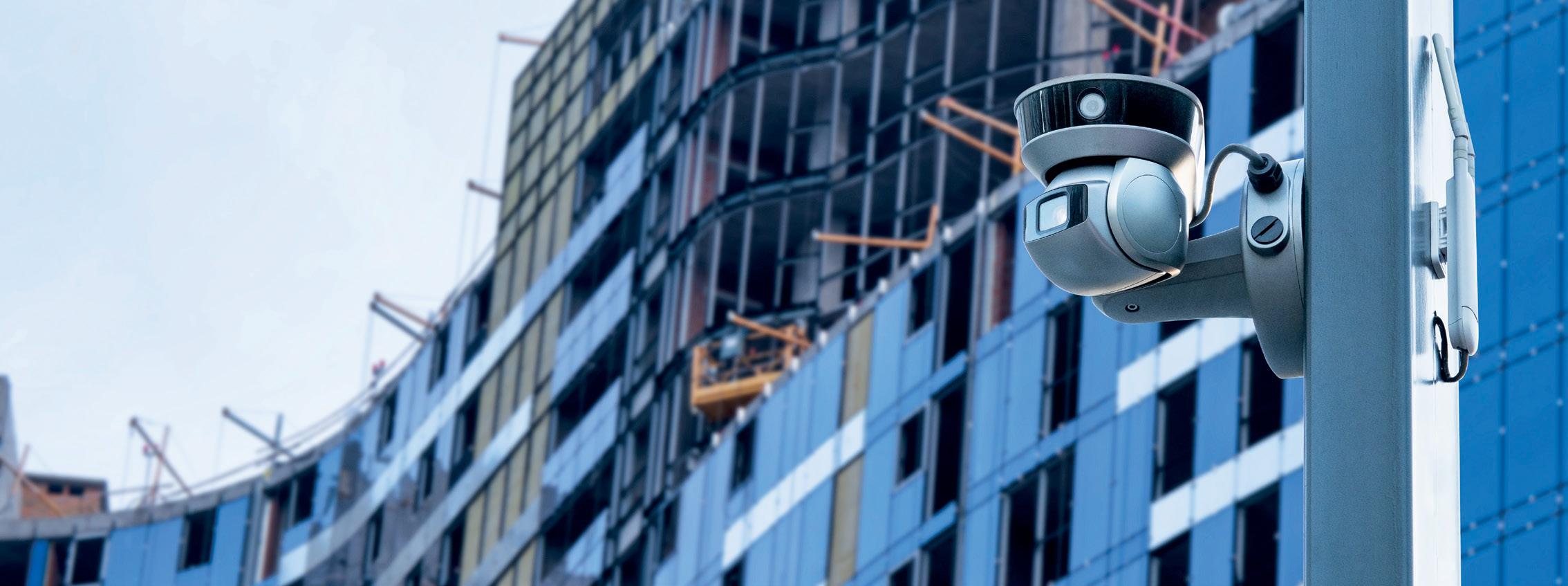
at the digital footage later on, when the thieves have long gone.
VIDEO MONITORING SECURITY SOLUTIONS
In conjunction with video surveillance, professional video monitoring is another layer of protection to add to the security plan. Highly trained professionals can monitor the site via video surveillance - and they know what to look for and how to react. Professional monitoring will quickly dispatch authorities when needed and actively monitor the site when no one is there. Those who monitor will also contact site owners/ managers with concerns when appropriate.
SECURITY IS ALWAYS GOOD VALUE
Even given this raft of options, it’s not too difficult to see that while some require a level of up-front investment, they can represent very small sums compared to the assets left on-site - the loss of which can all too easily put significant and embarrassing dents in a company balance sheet…
Security cameras not only deter and indeed monitor intruders, but give powerful and valuable data about site footfall and visitor behaviour.
September 2023 meconstructionnews.com
44 | On Site
C M Y CM MY CY CMY K
since 1956
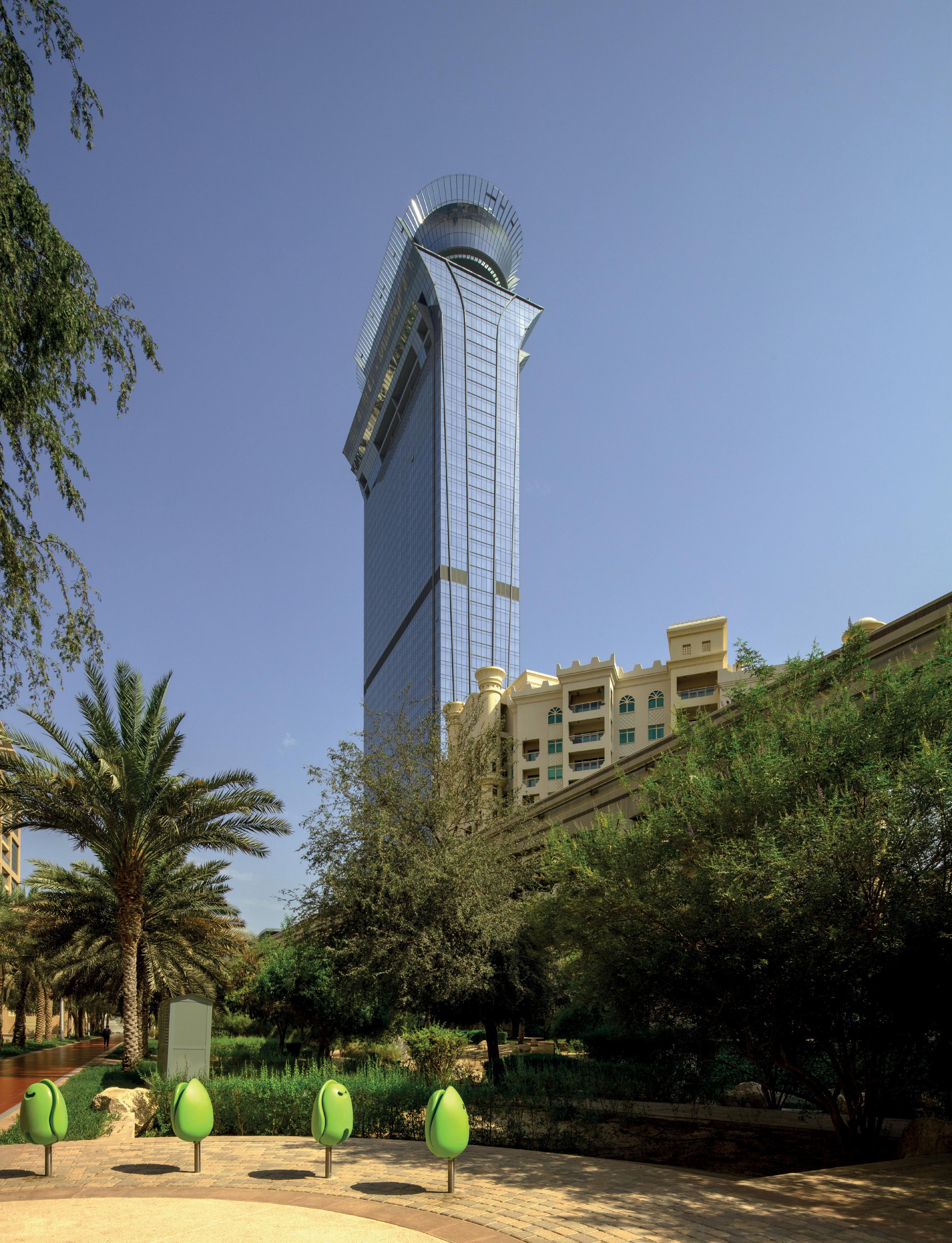
CELEBR AT E
A R CHI TECTU R A L i nno v a ti o n
A ST O UND I N G su cc es s

G LO B AL r ec o g n itio n
I N O VE R 2500+ P R O JE C T S
D E S IG N RE -I M A G IN E D












































































